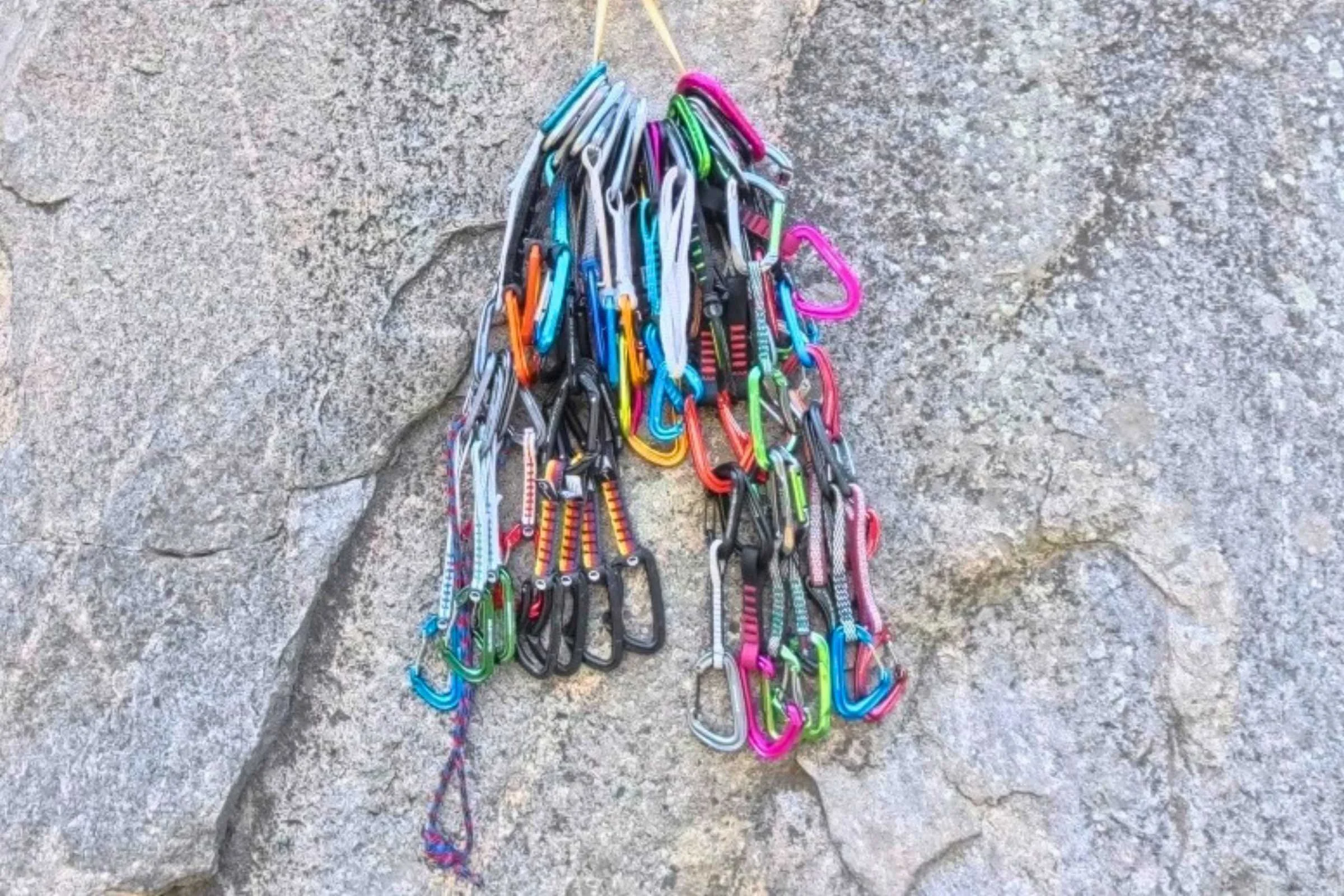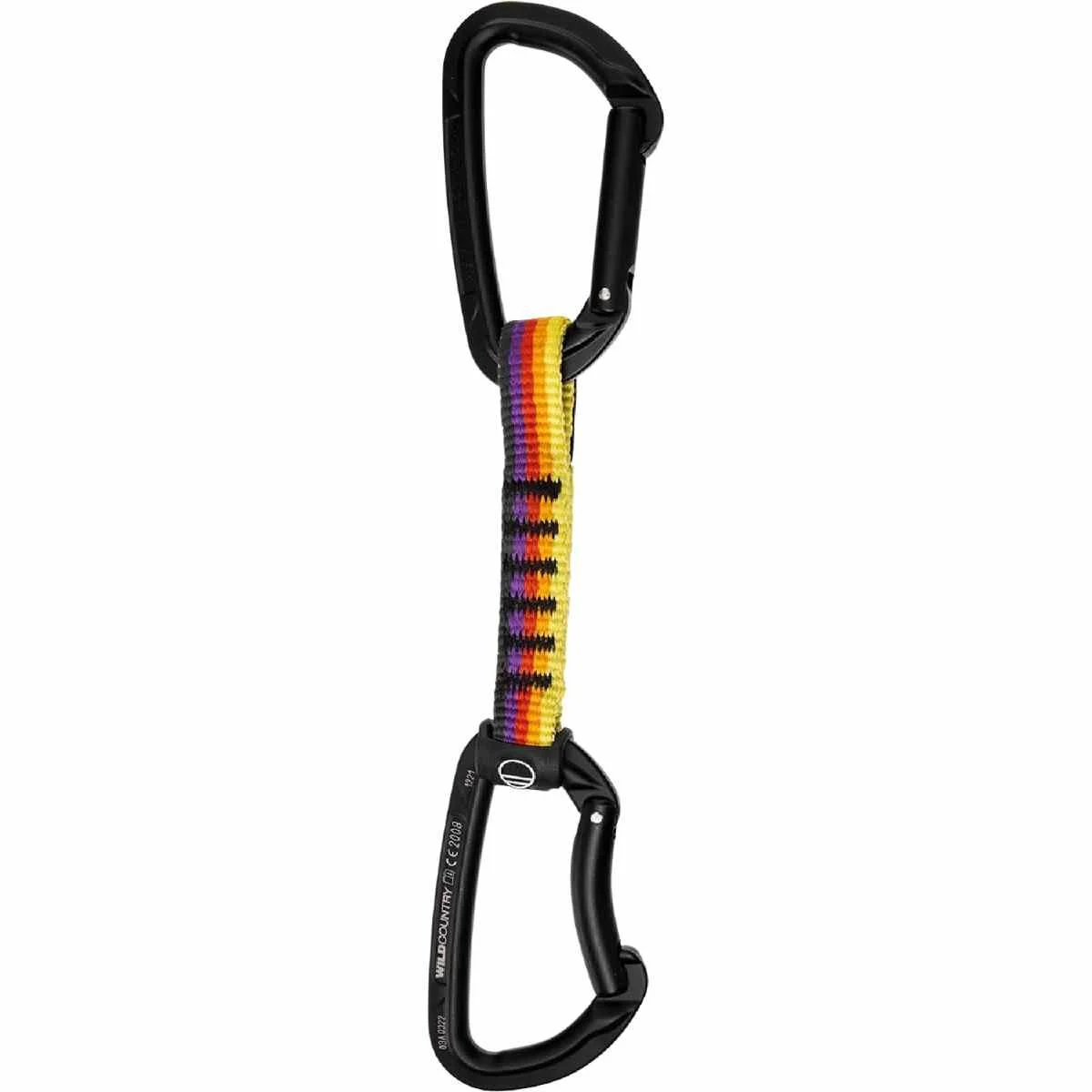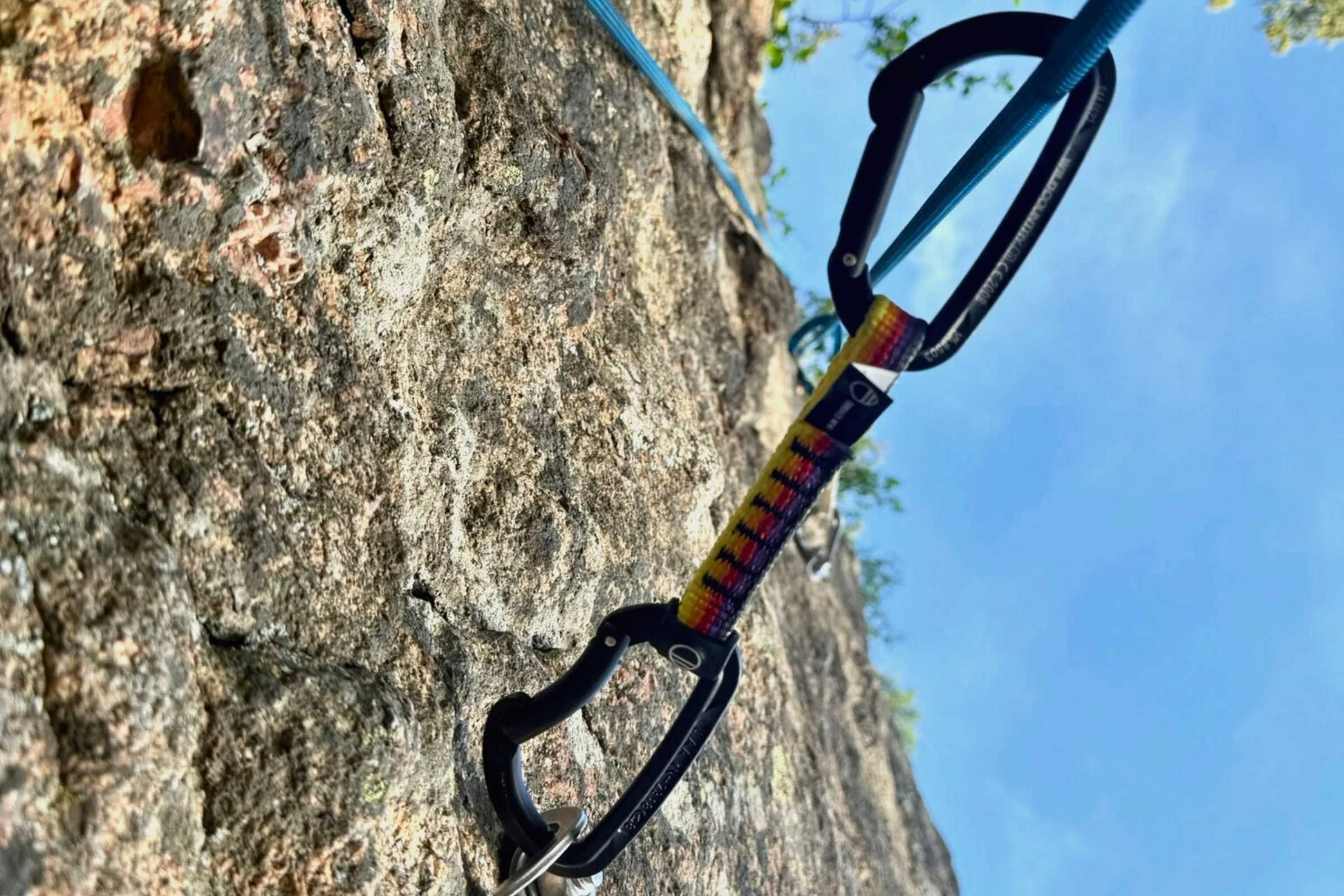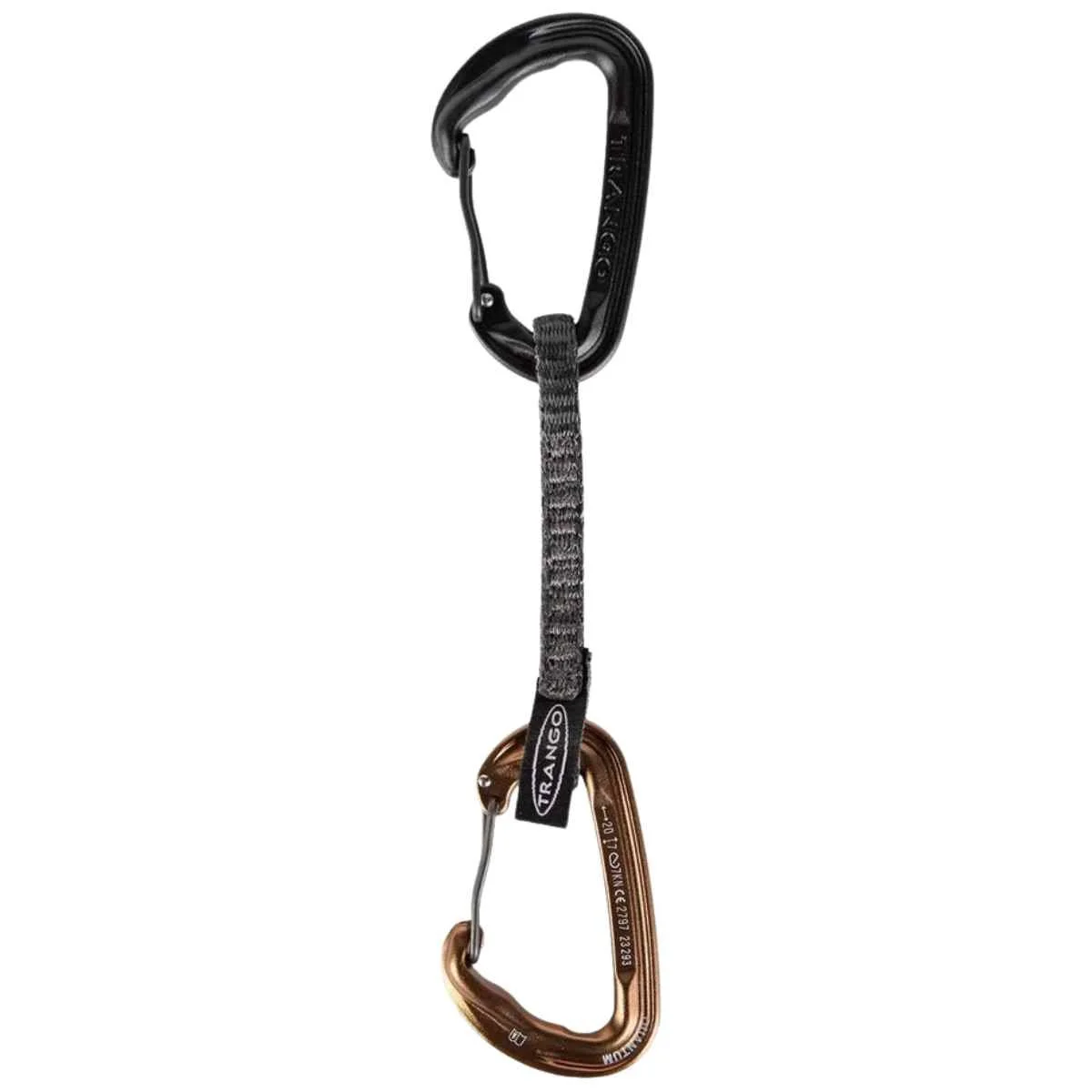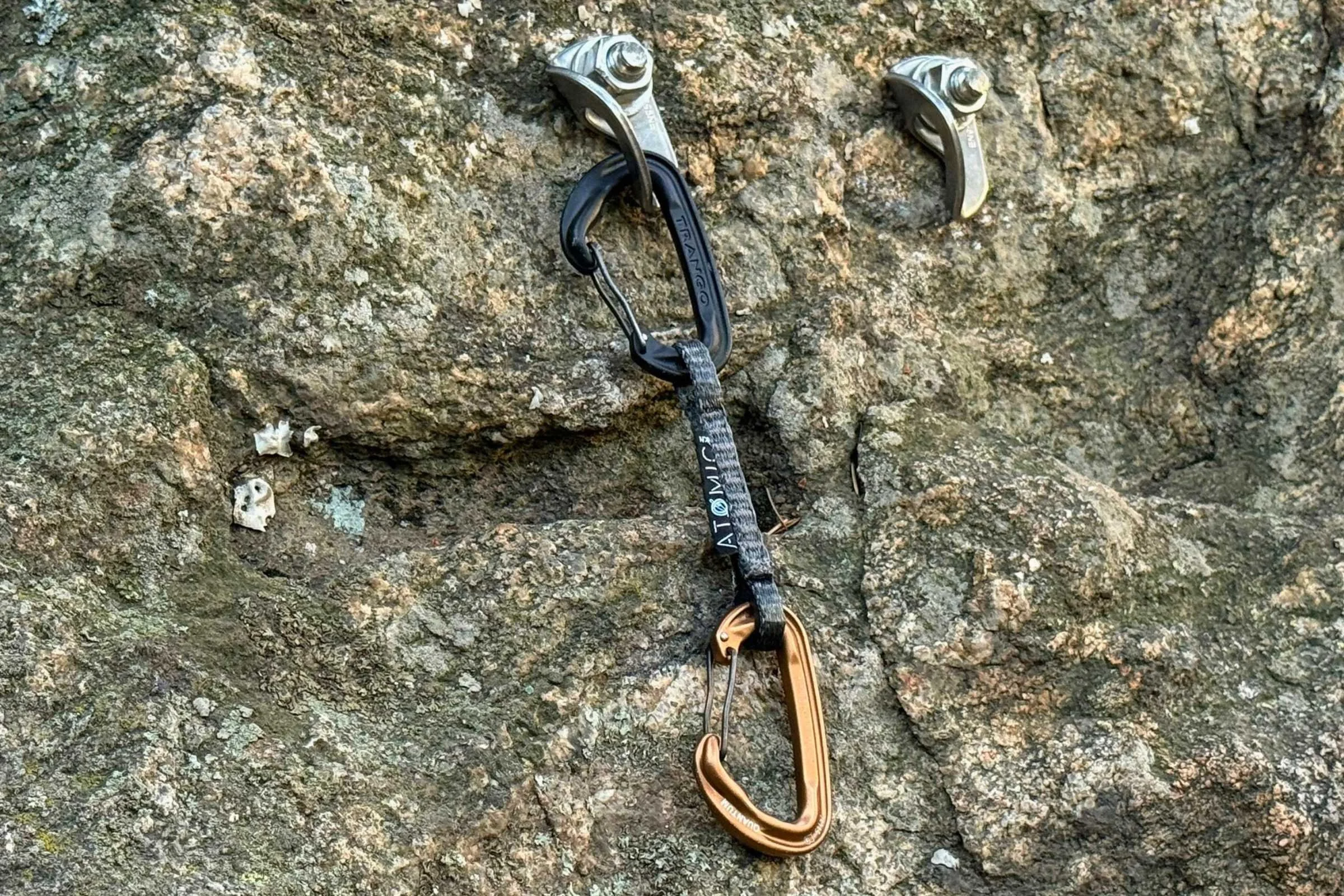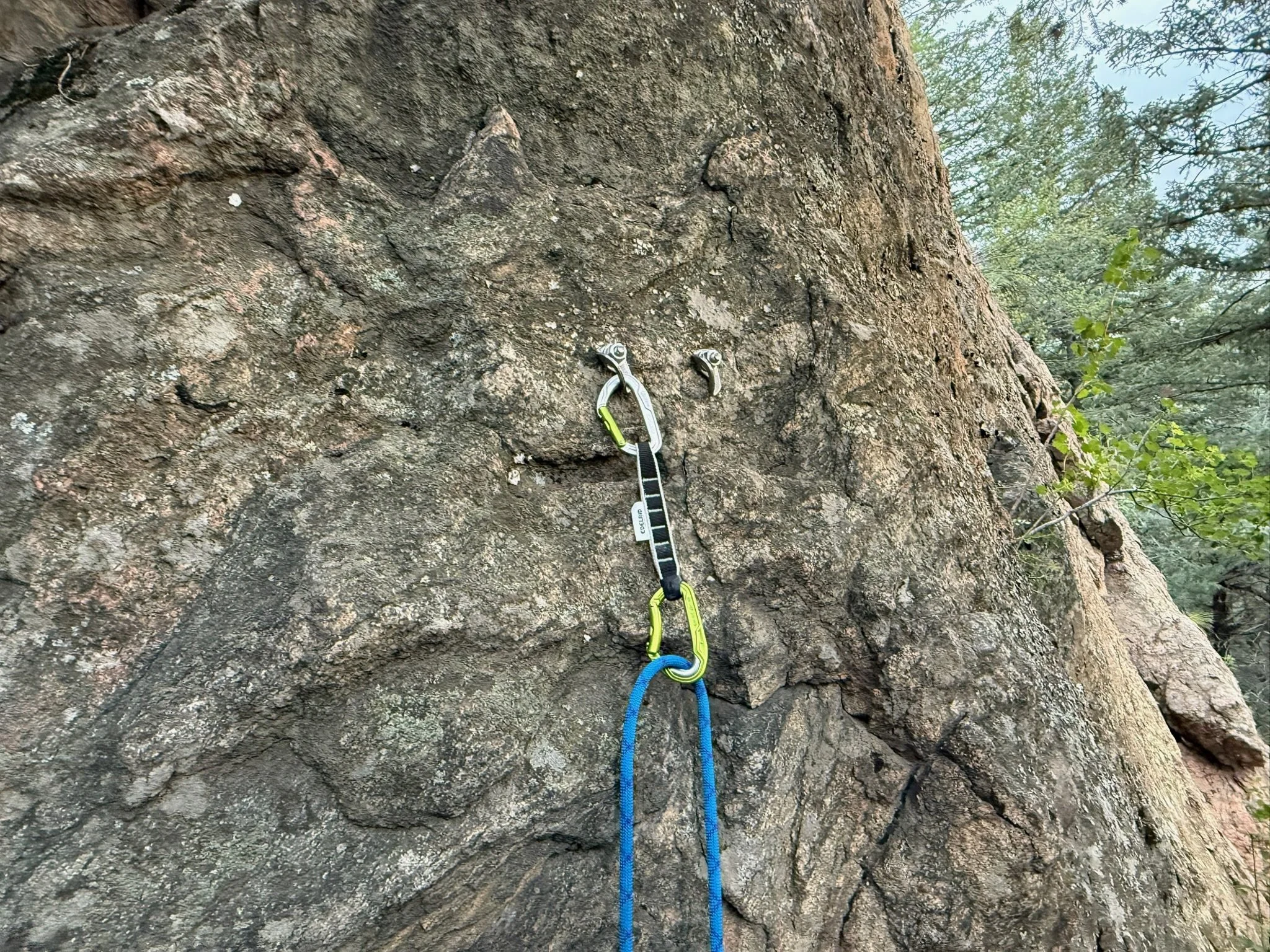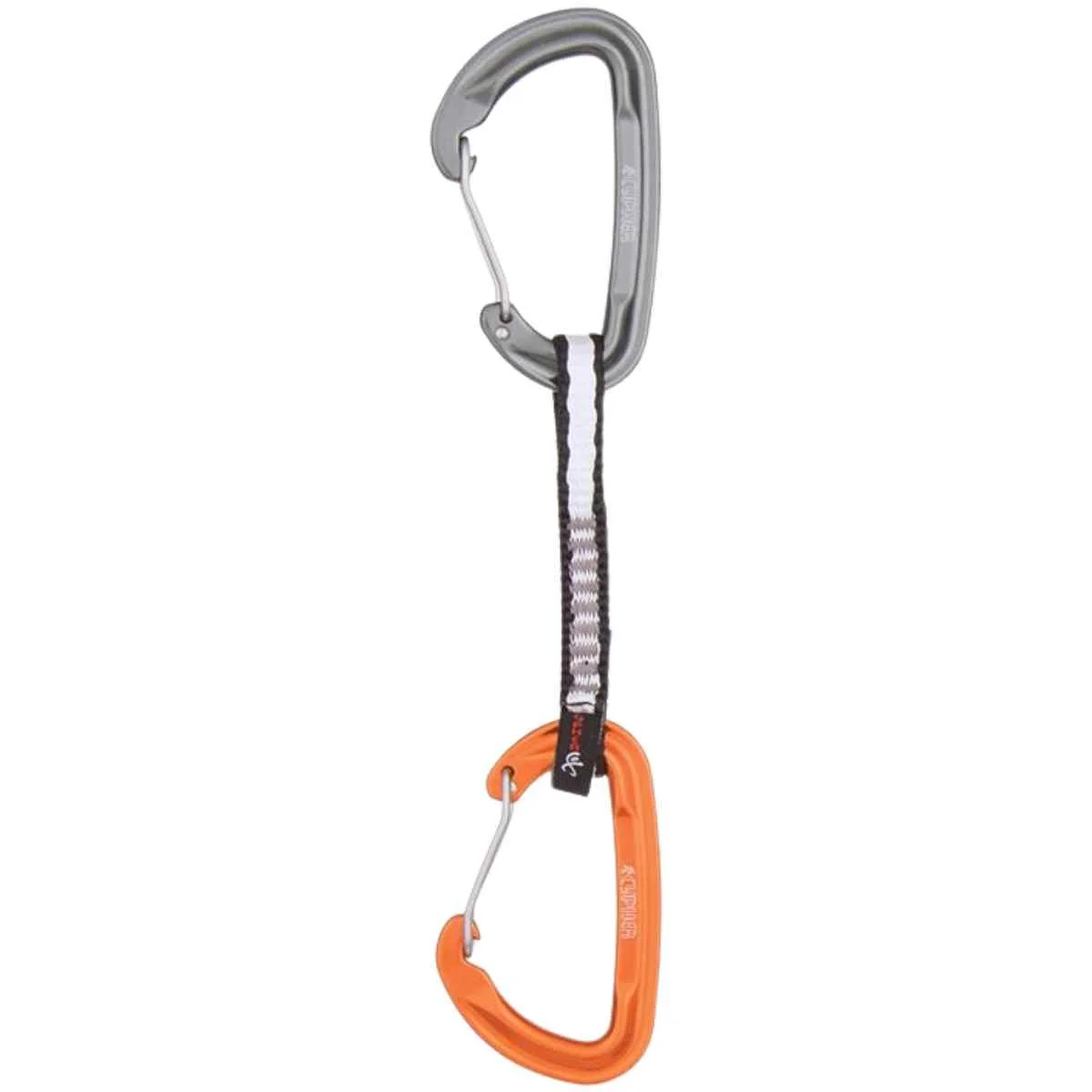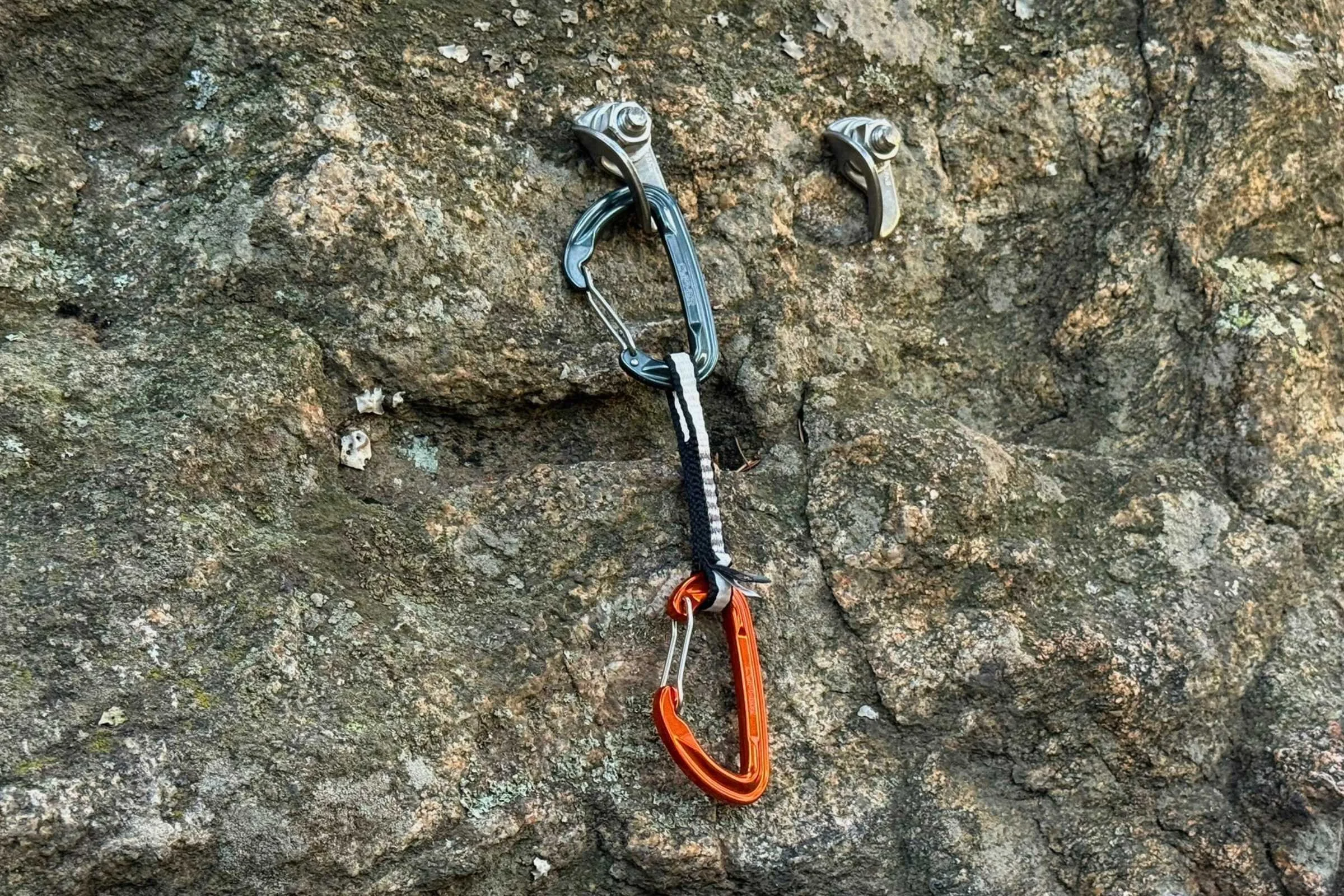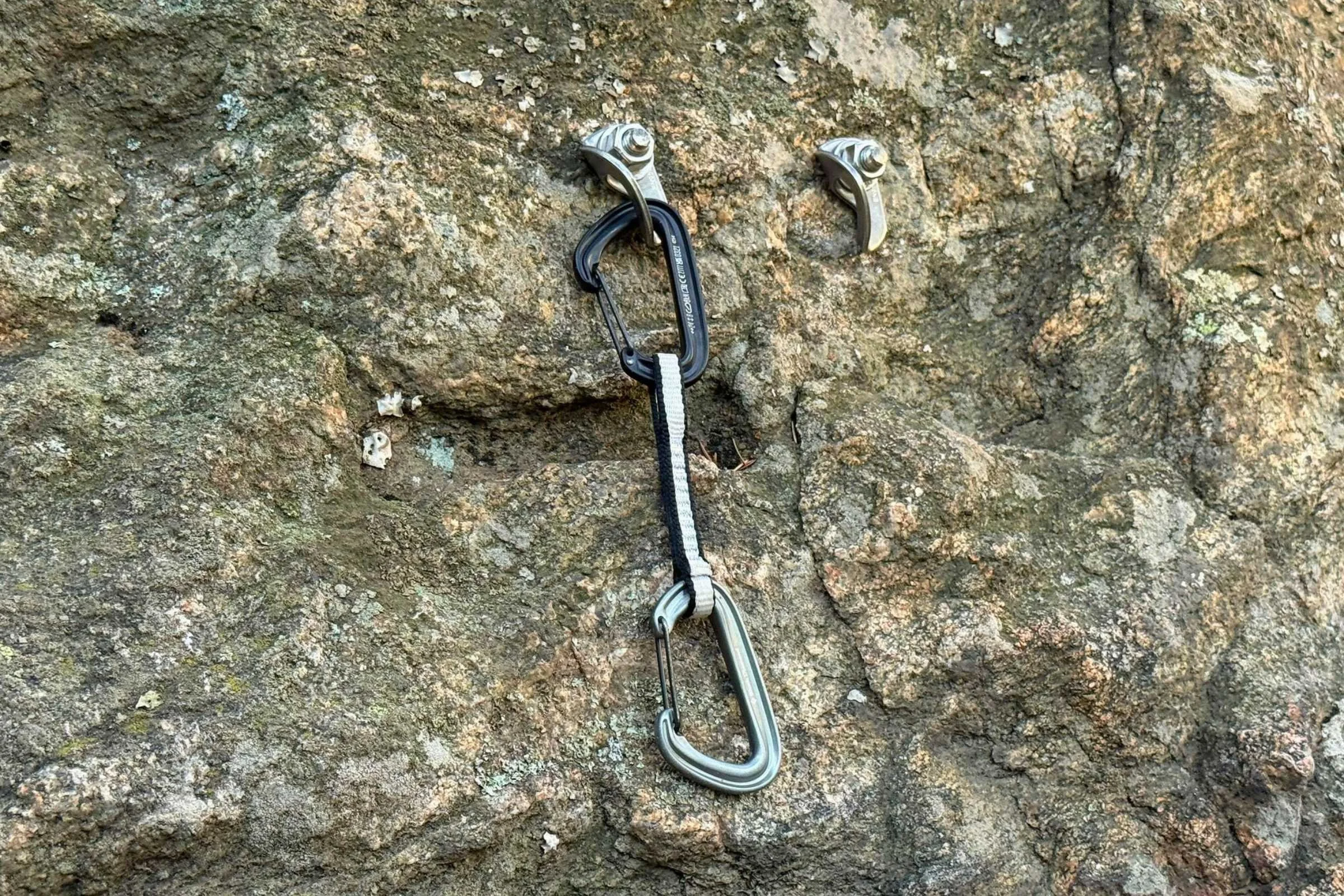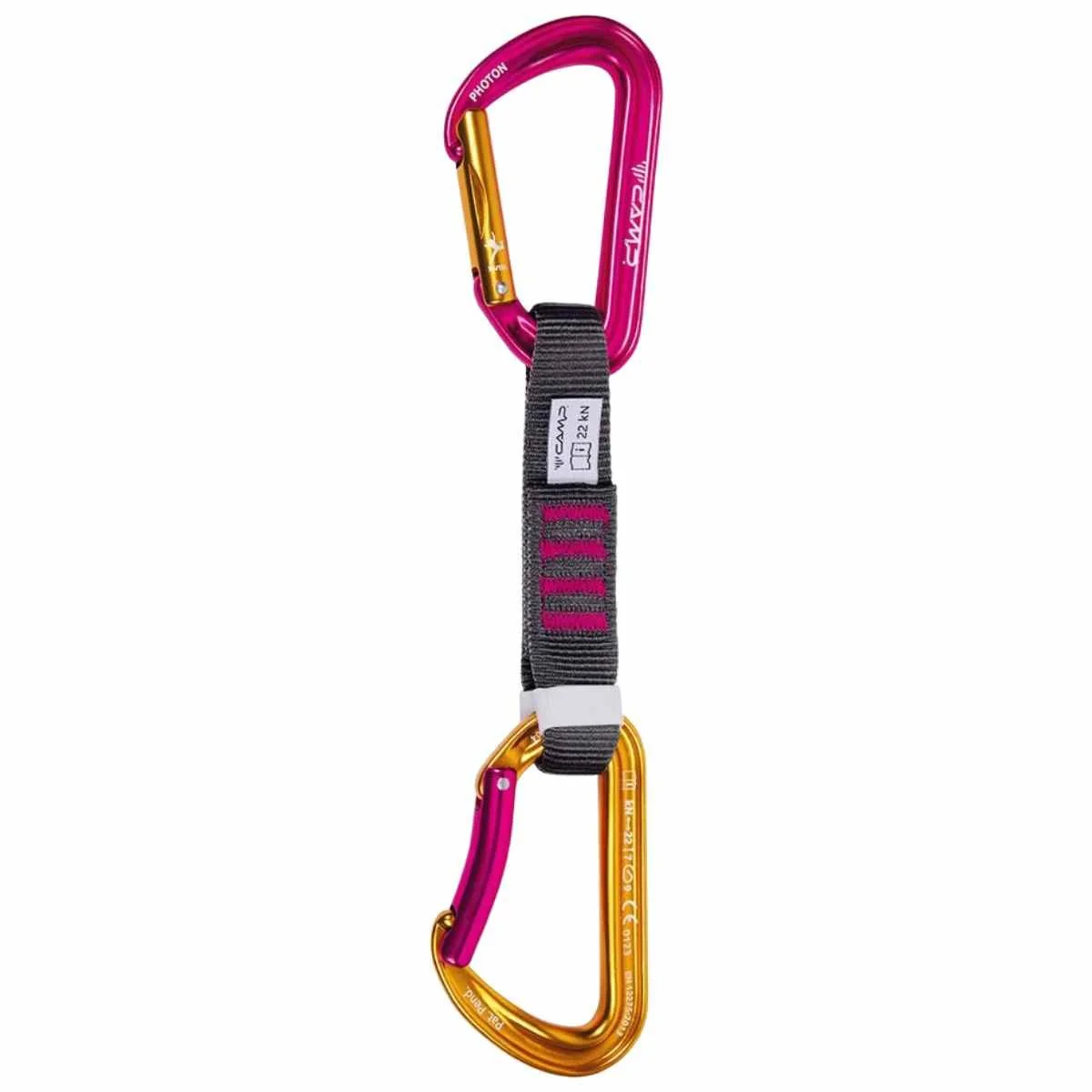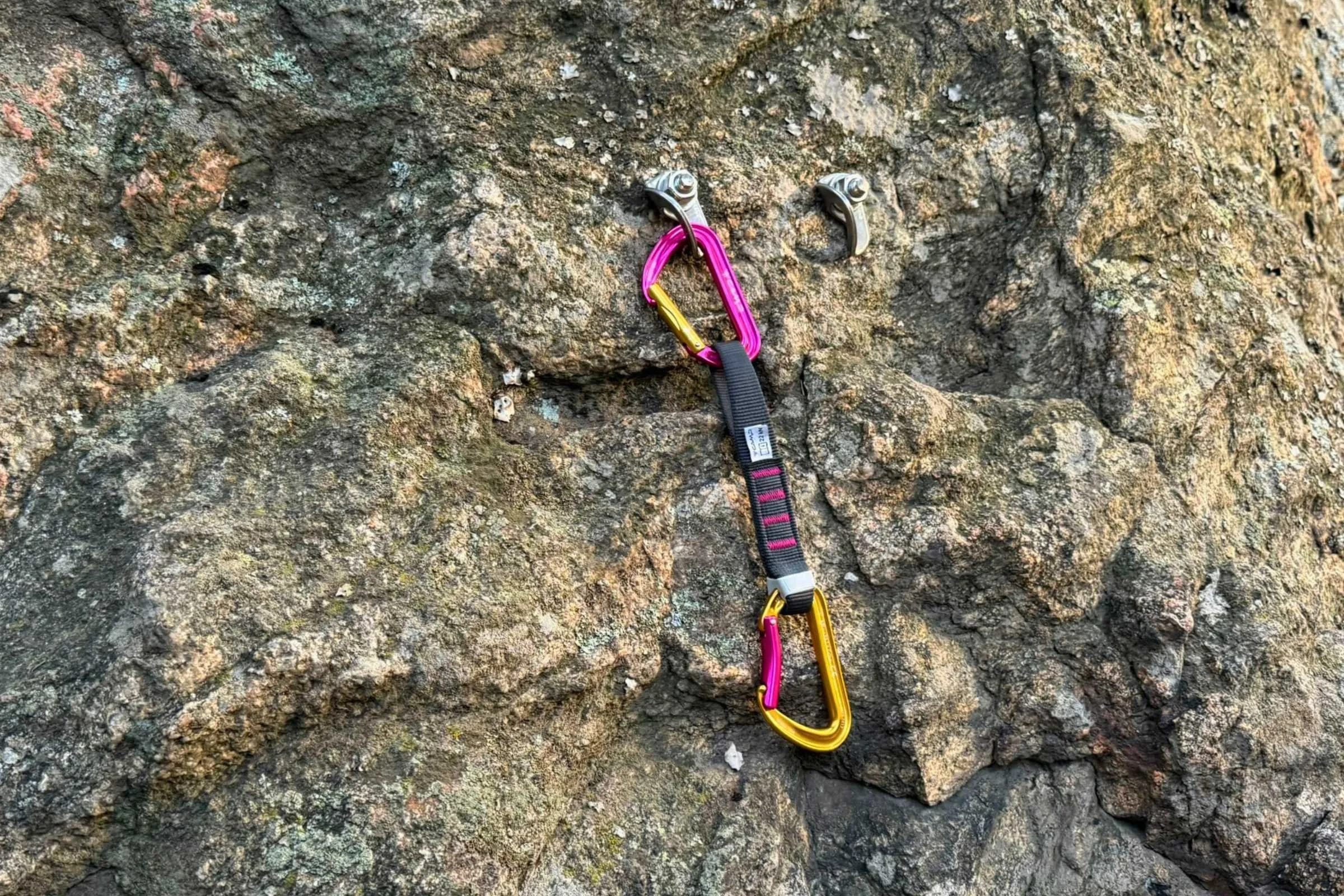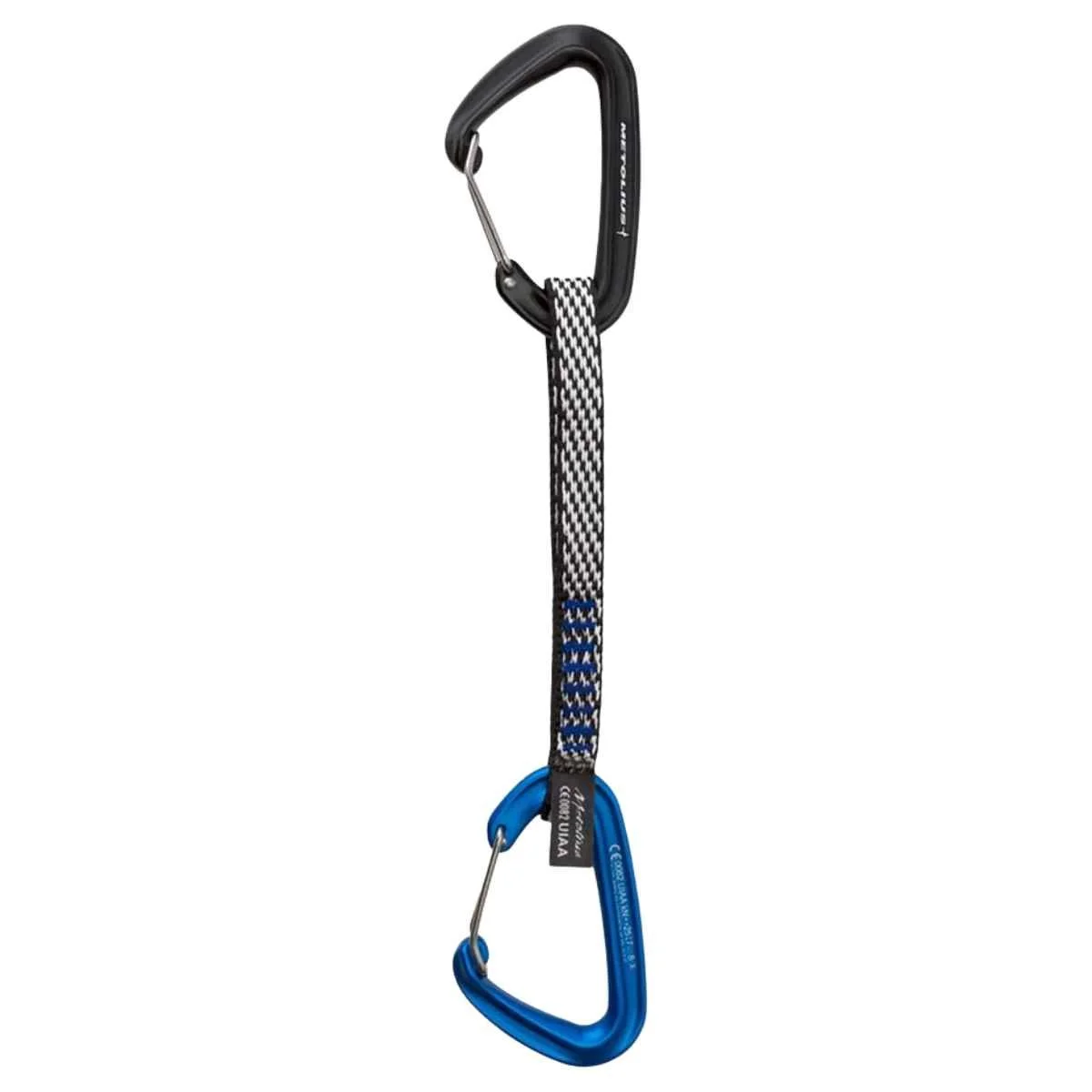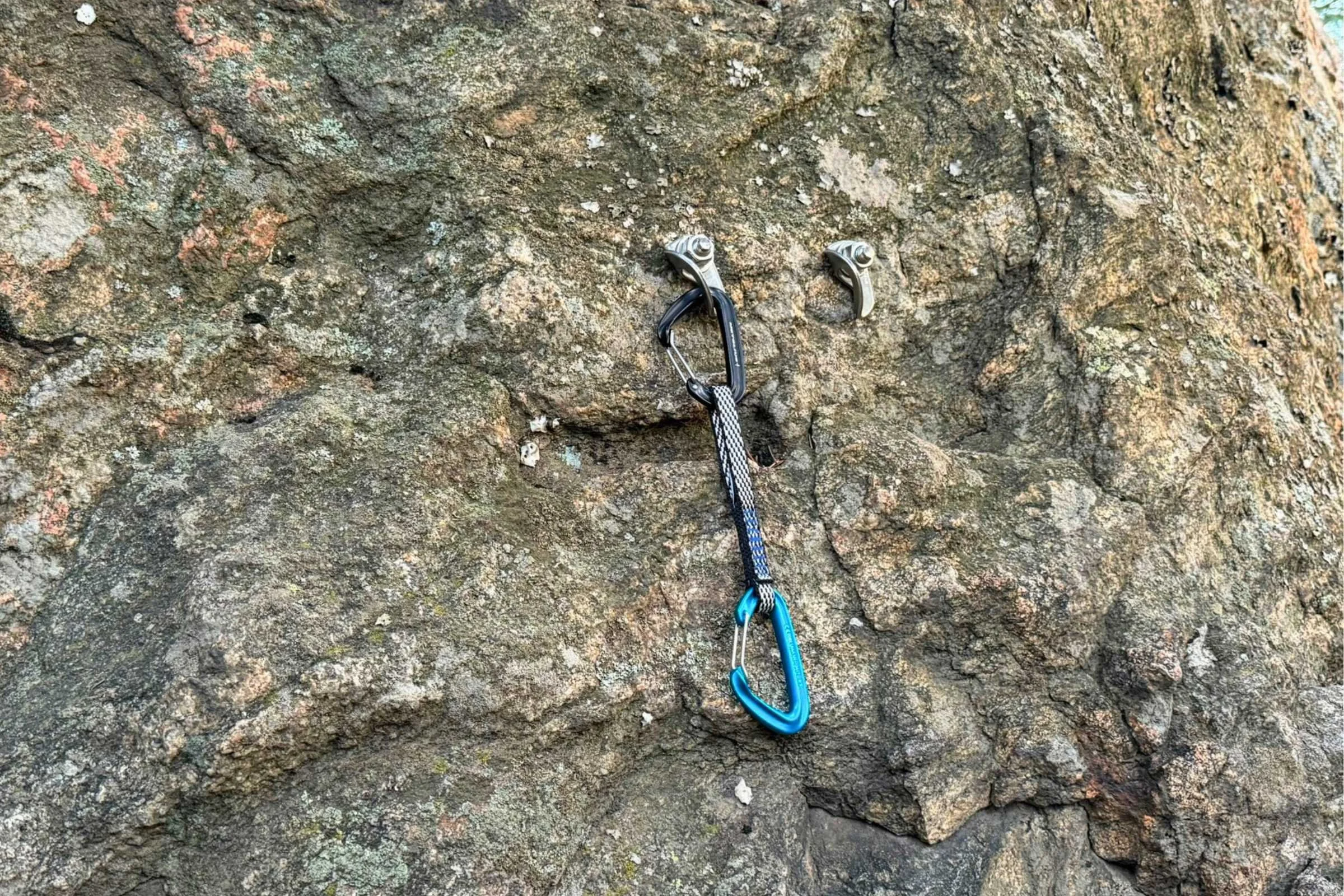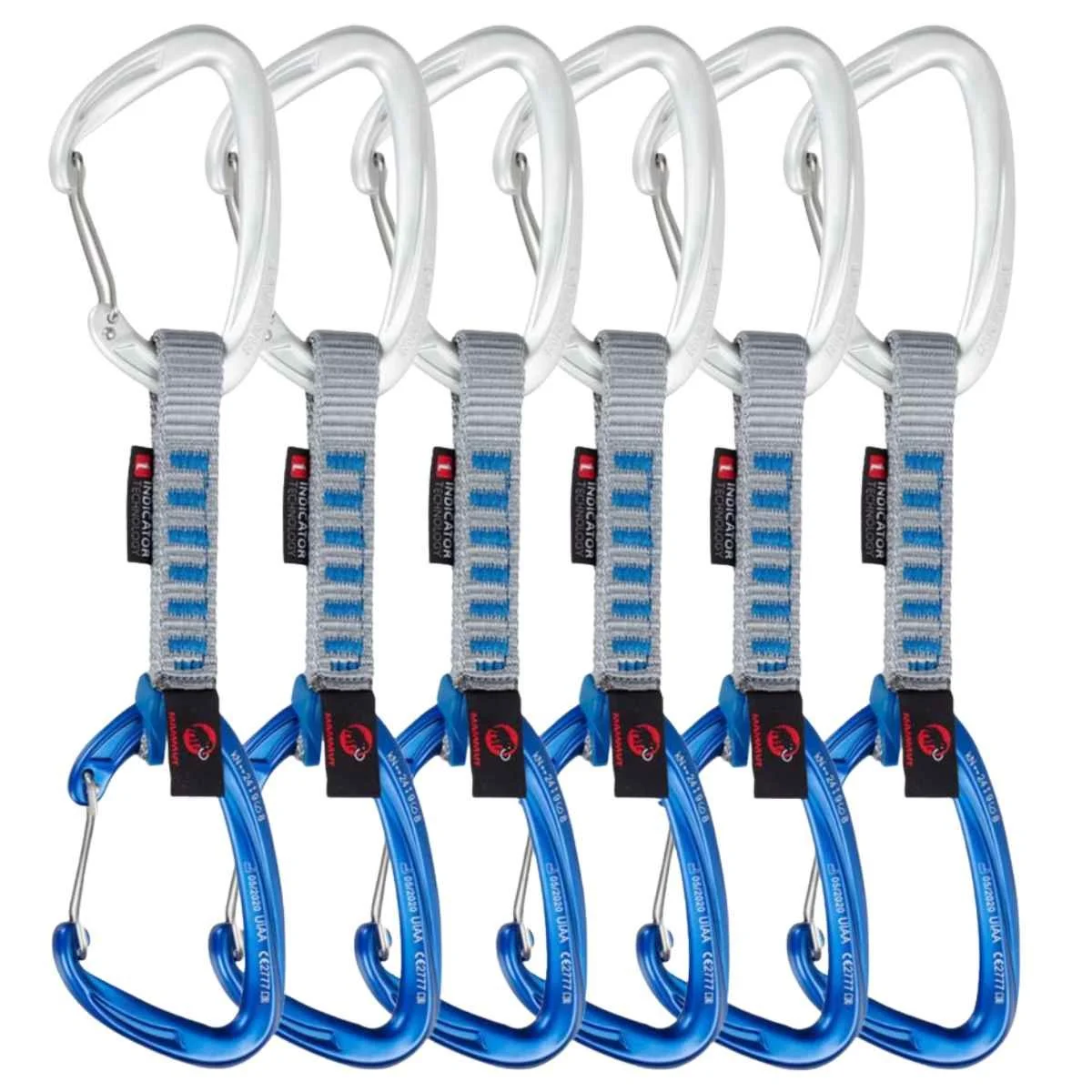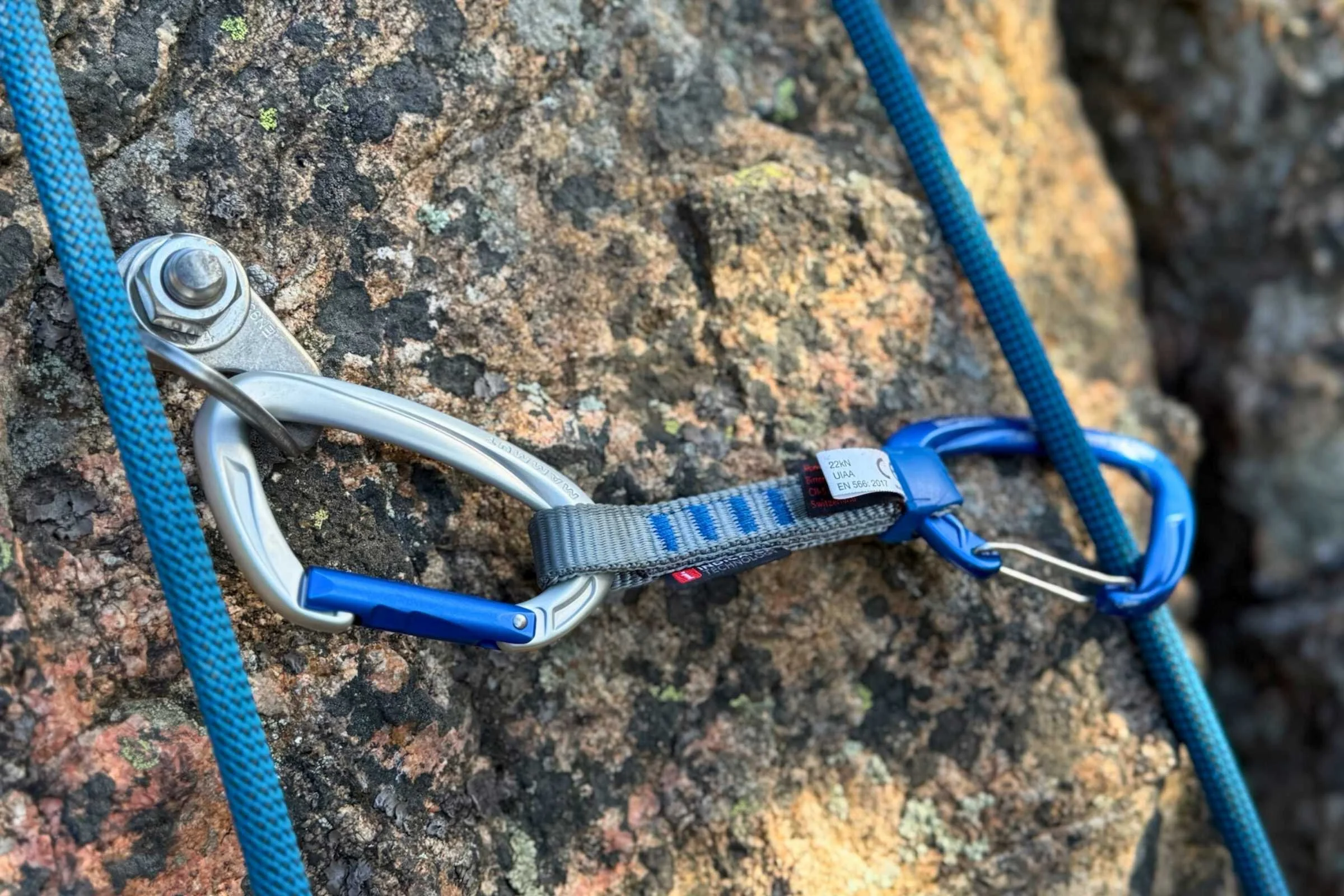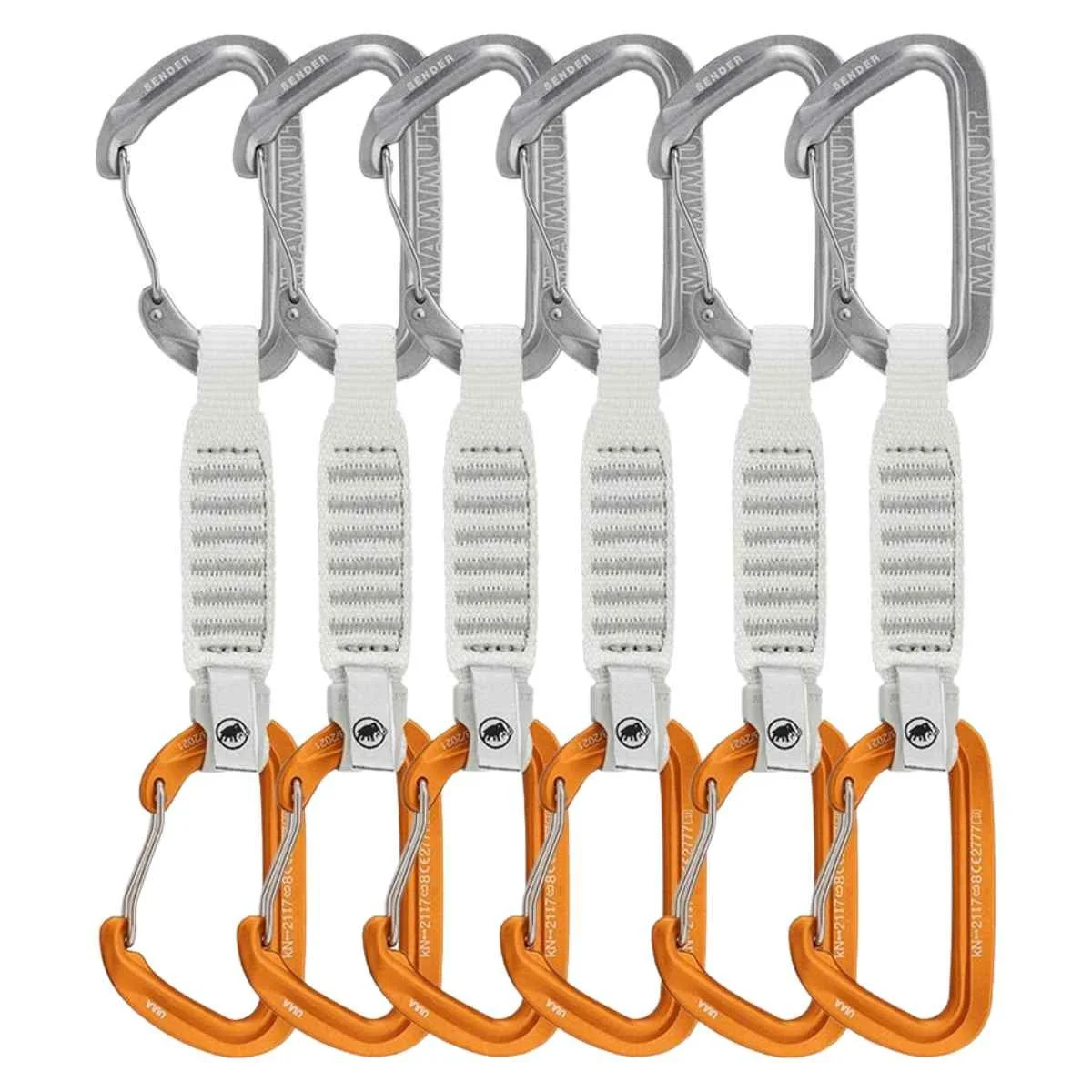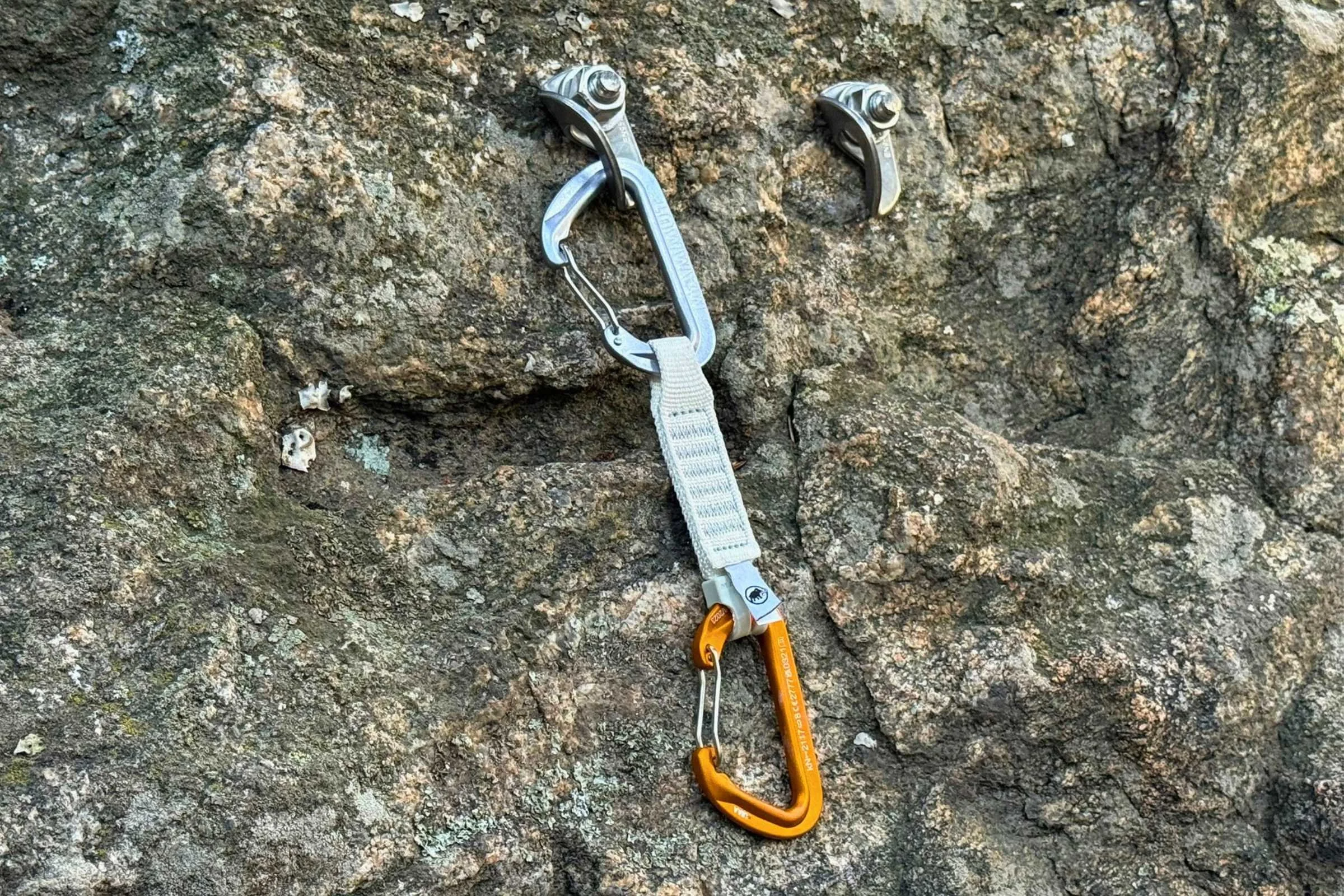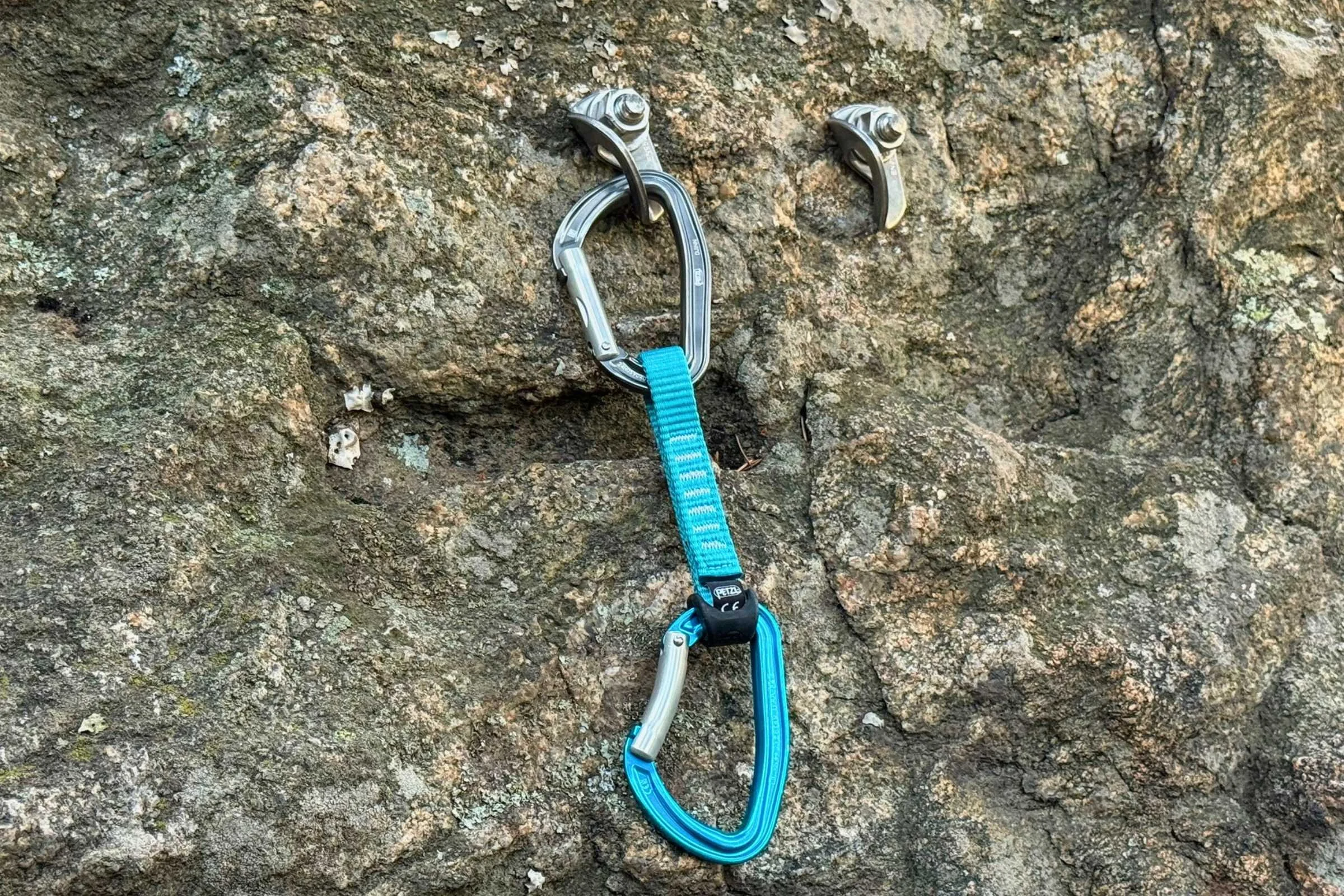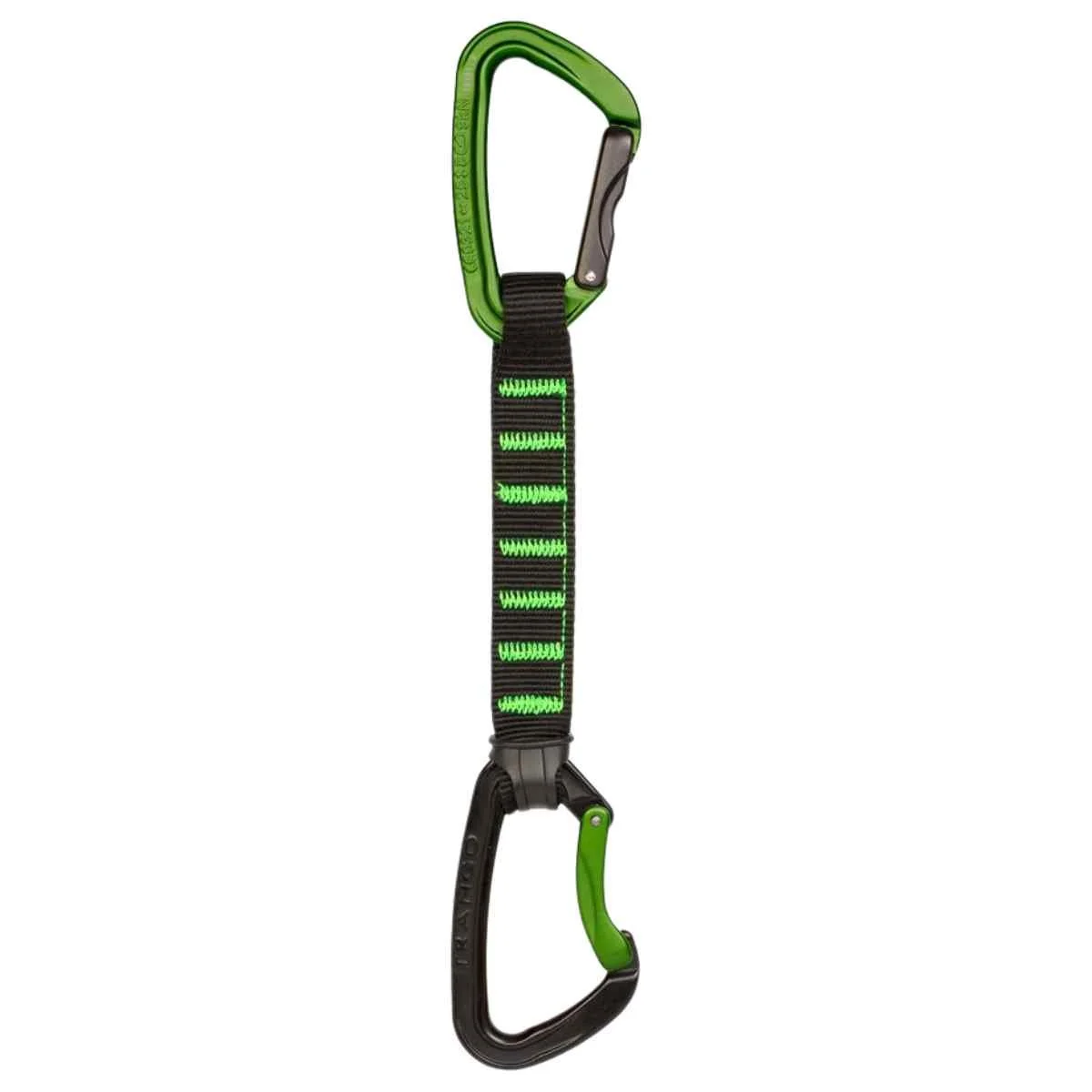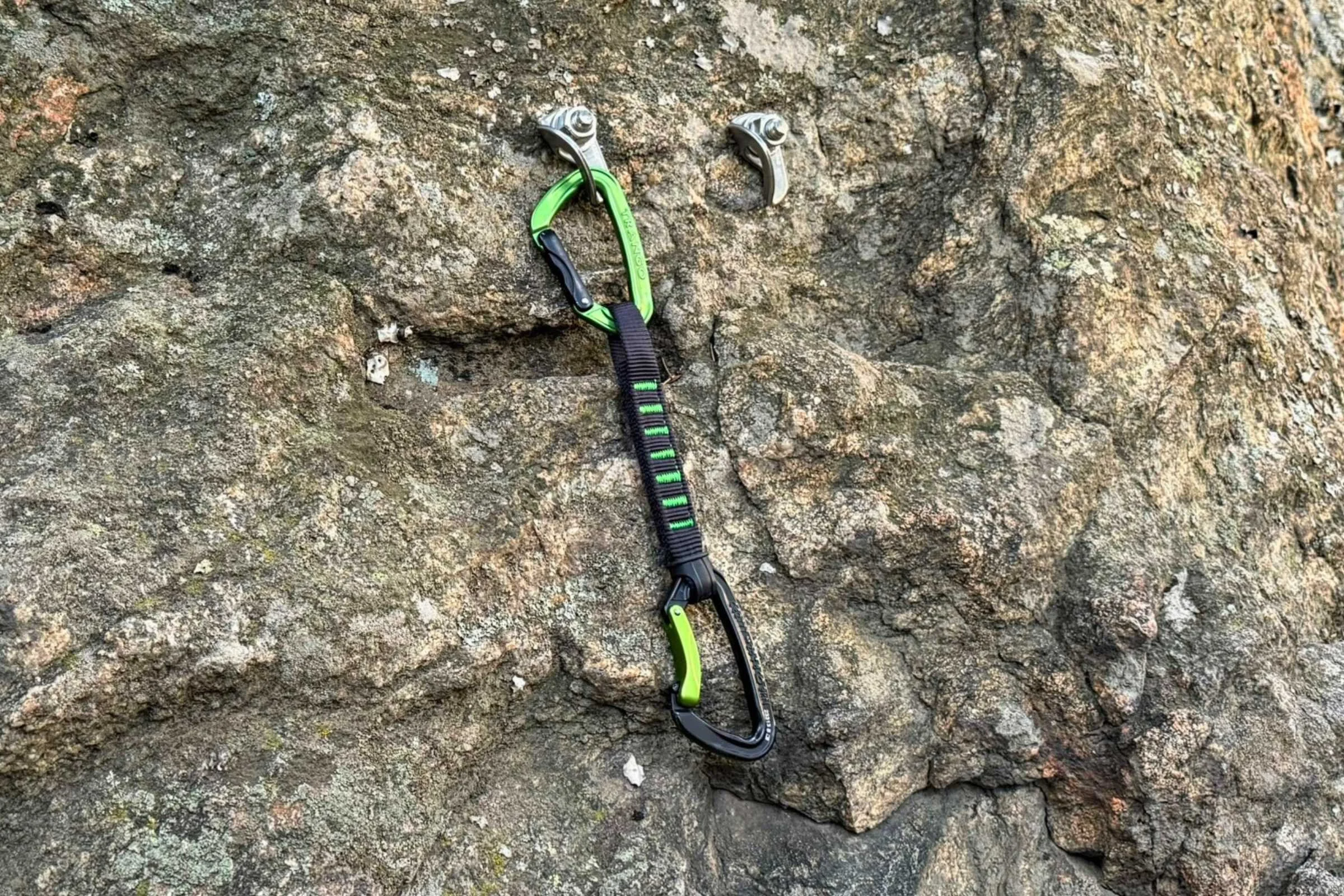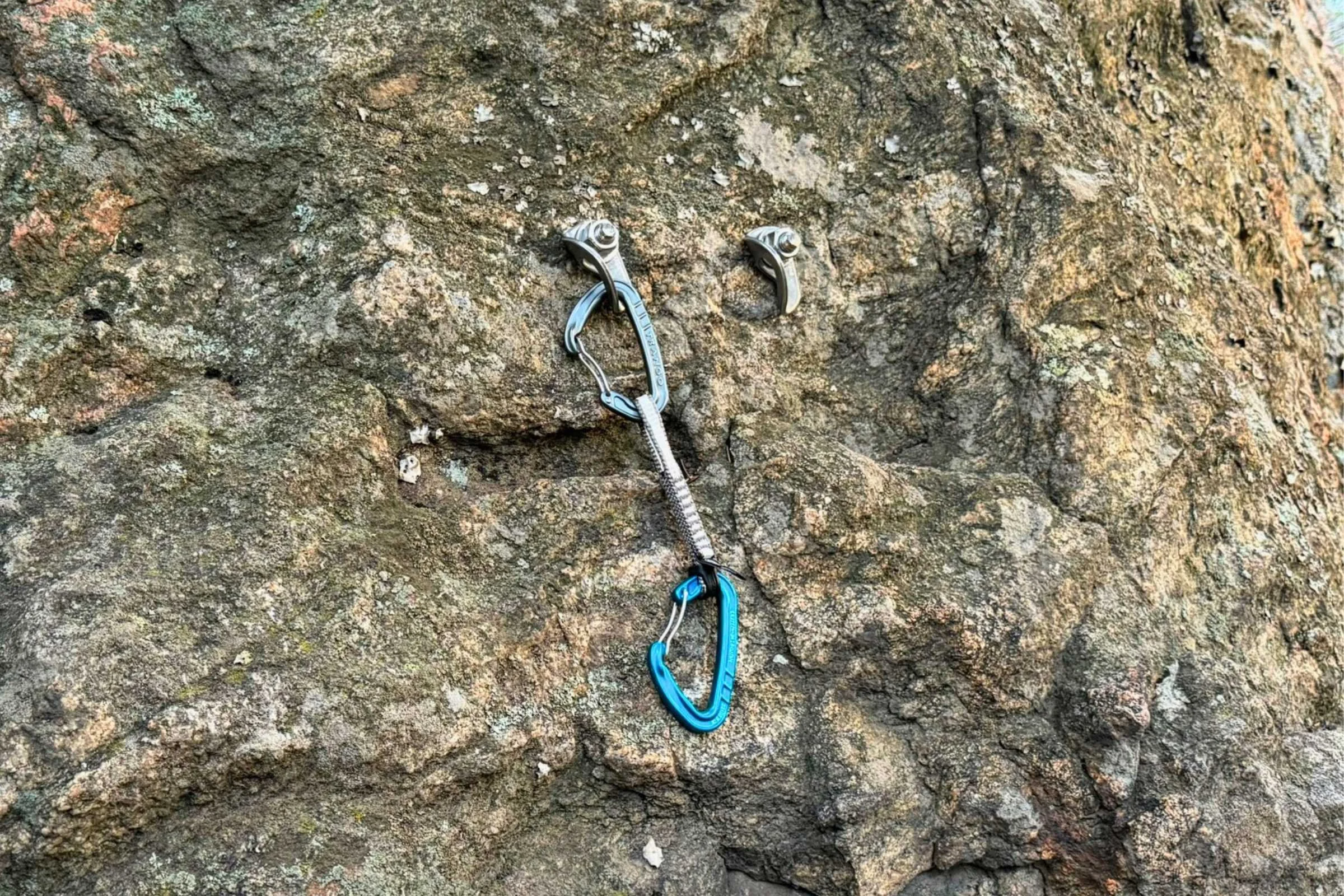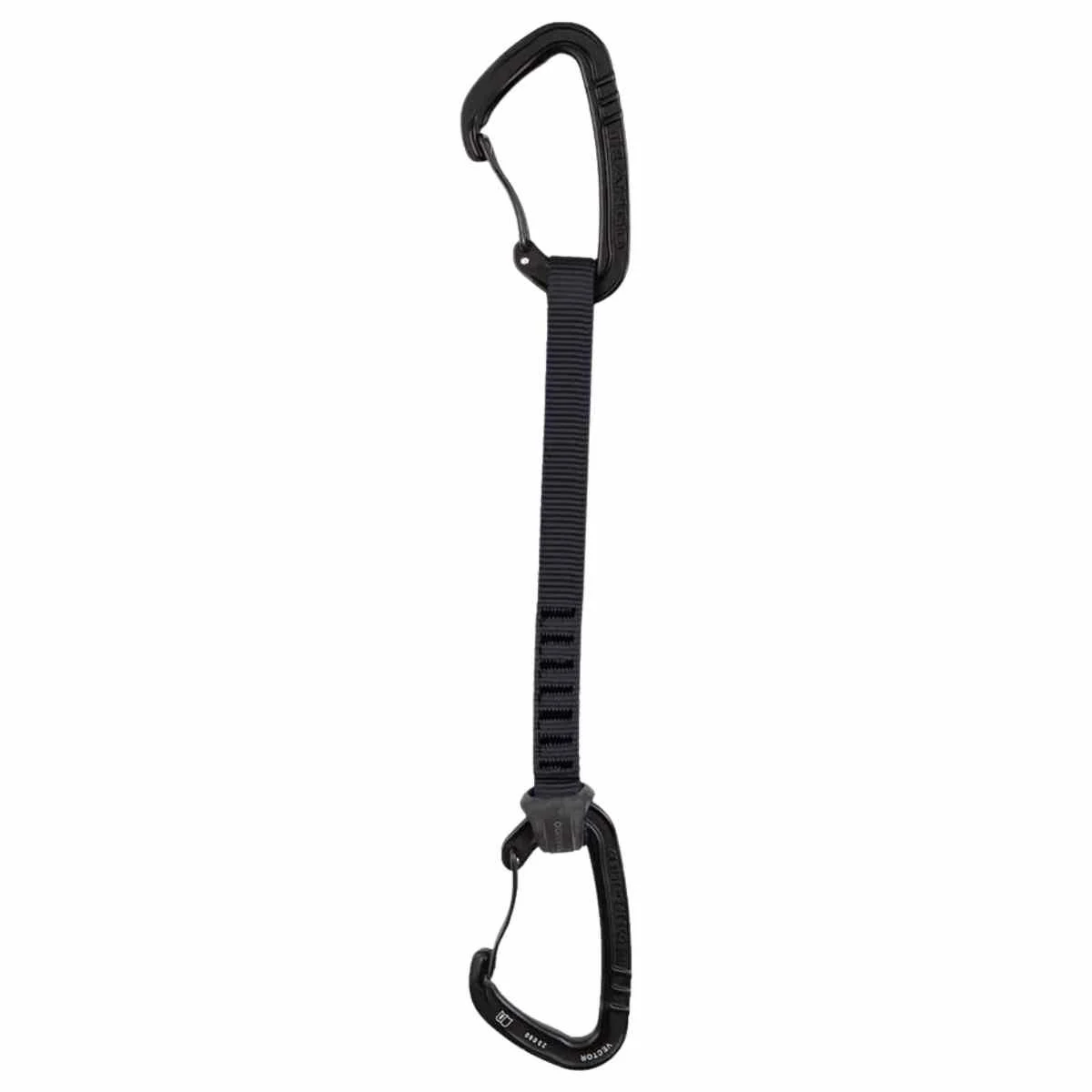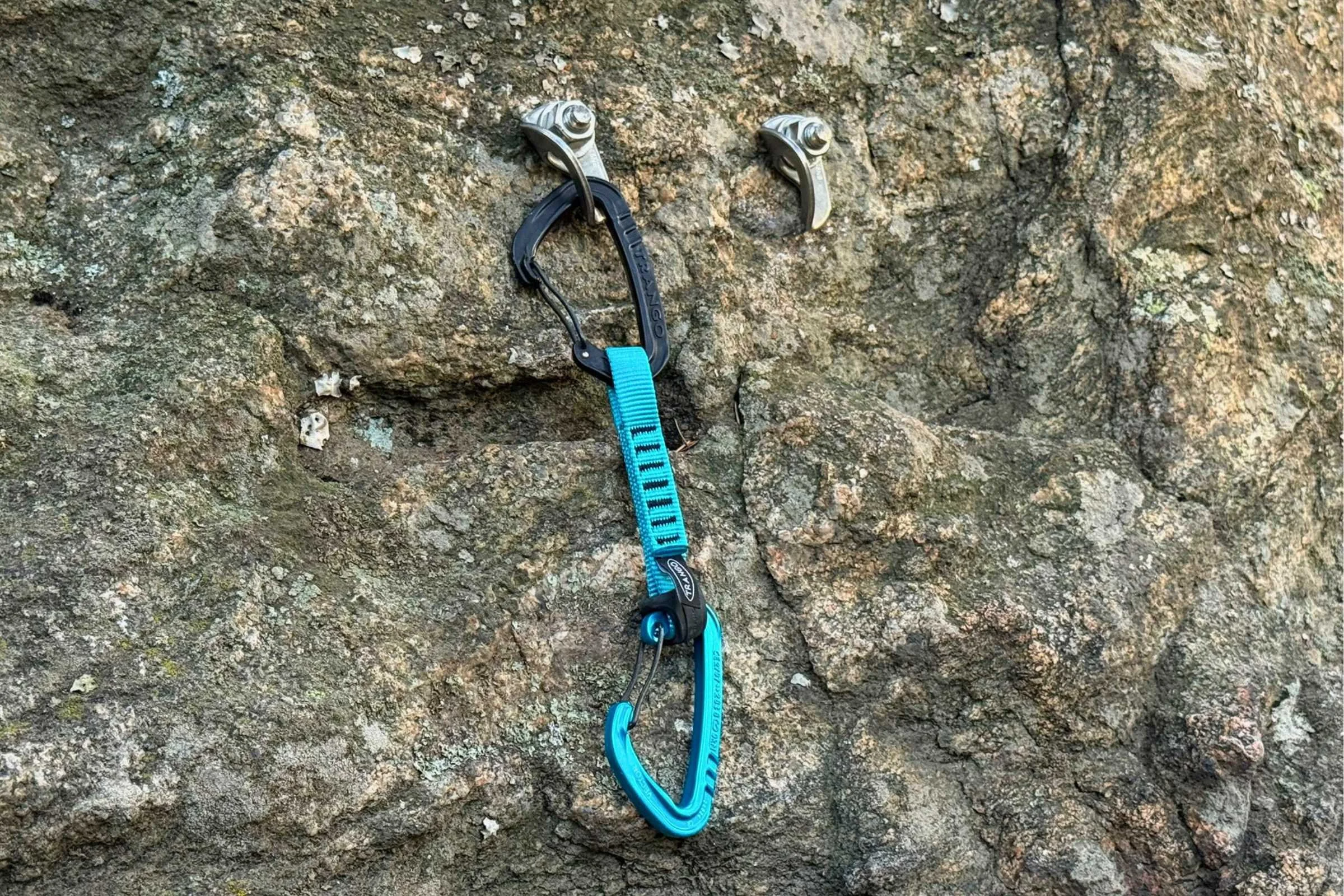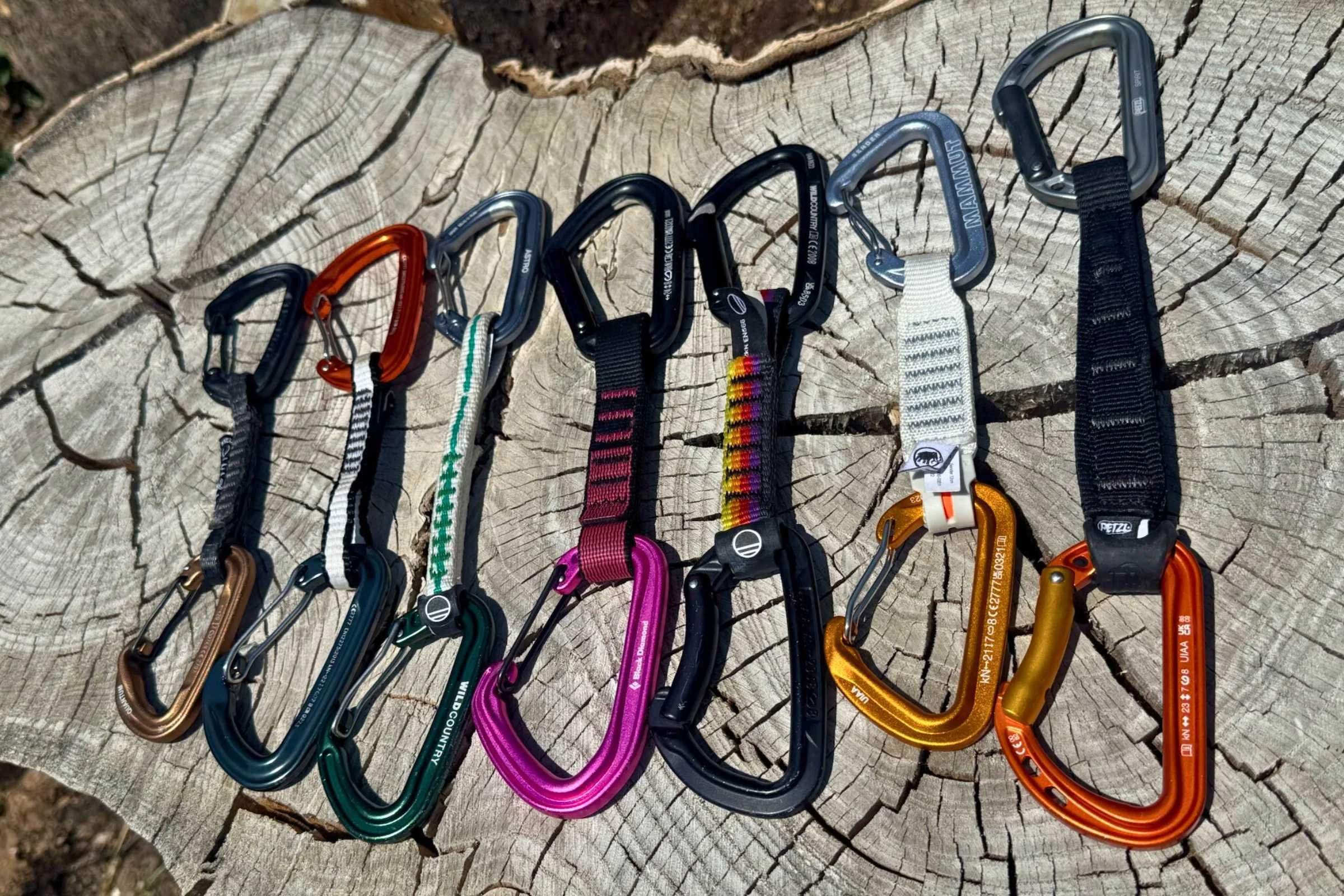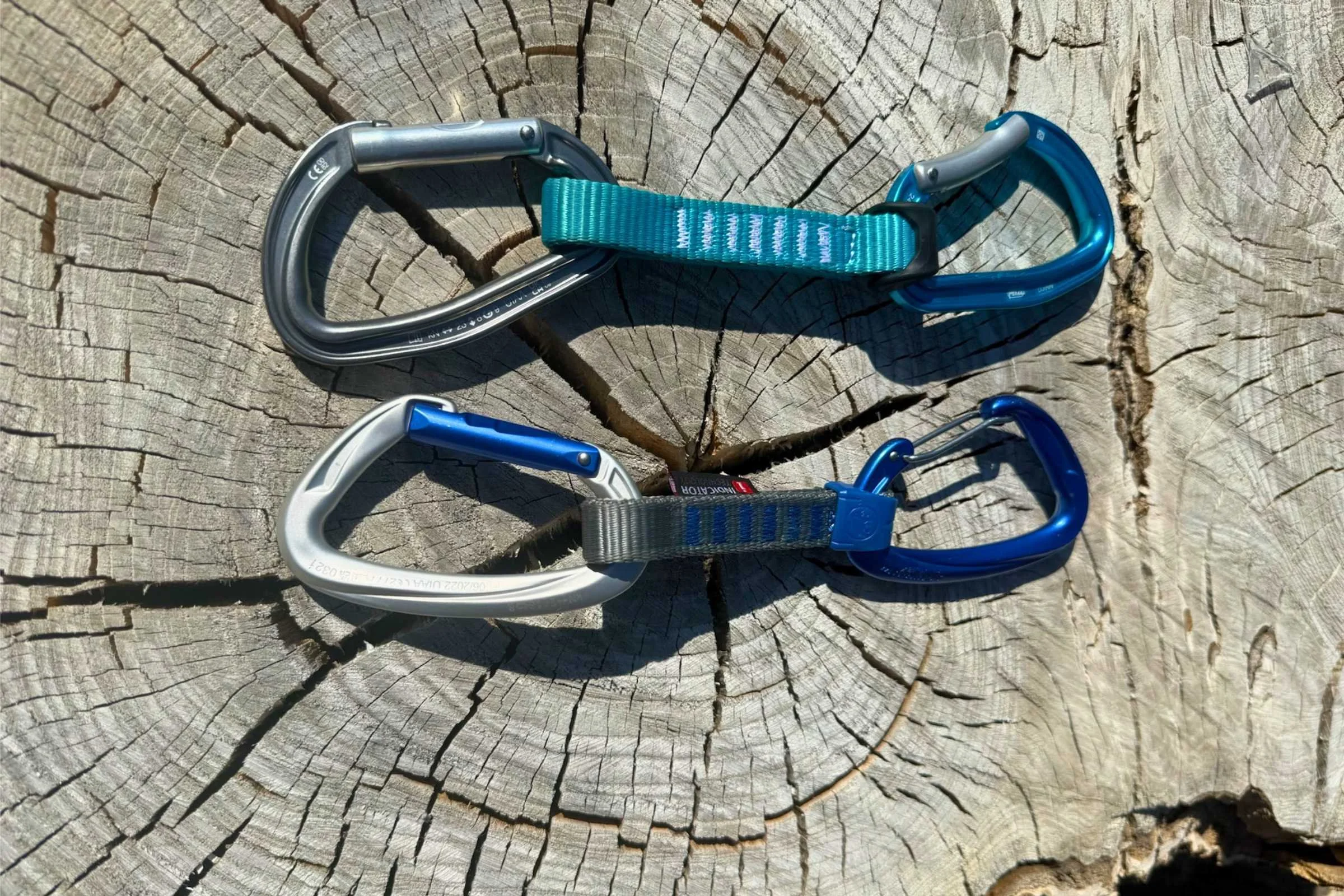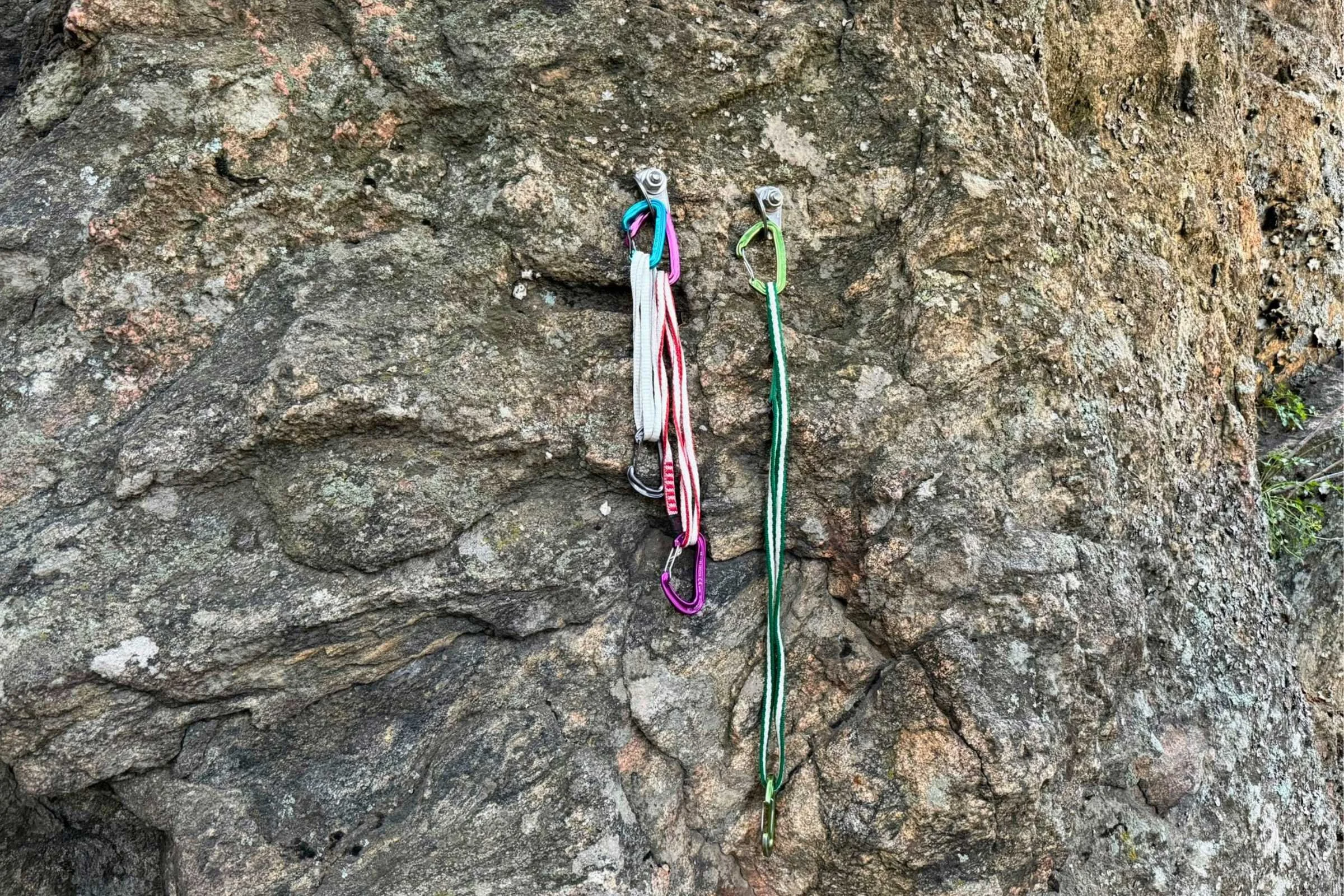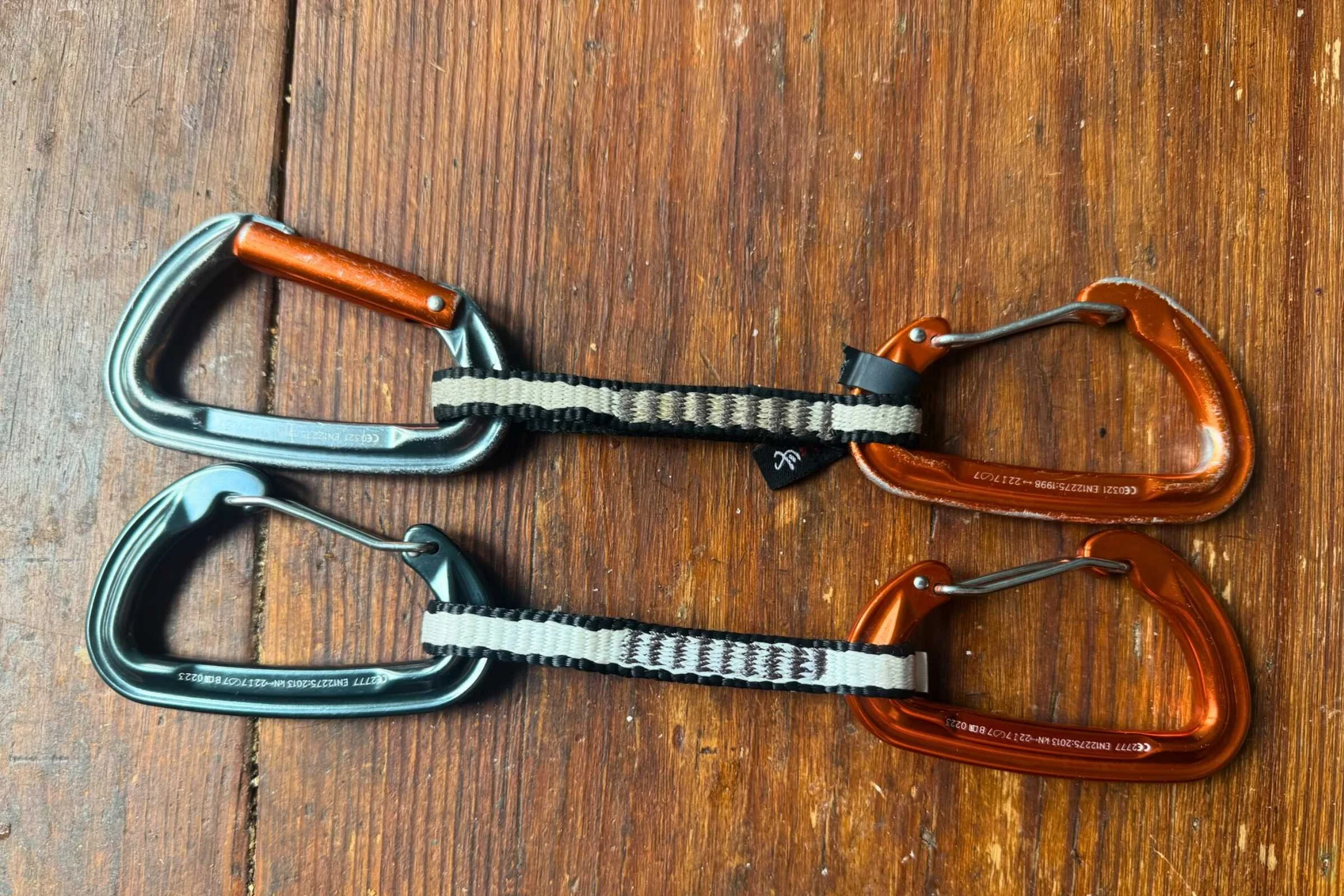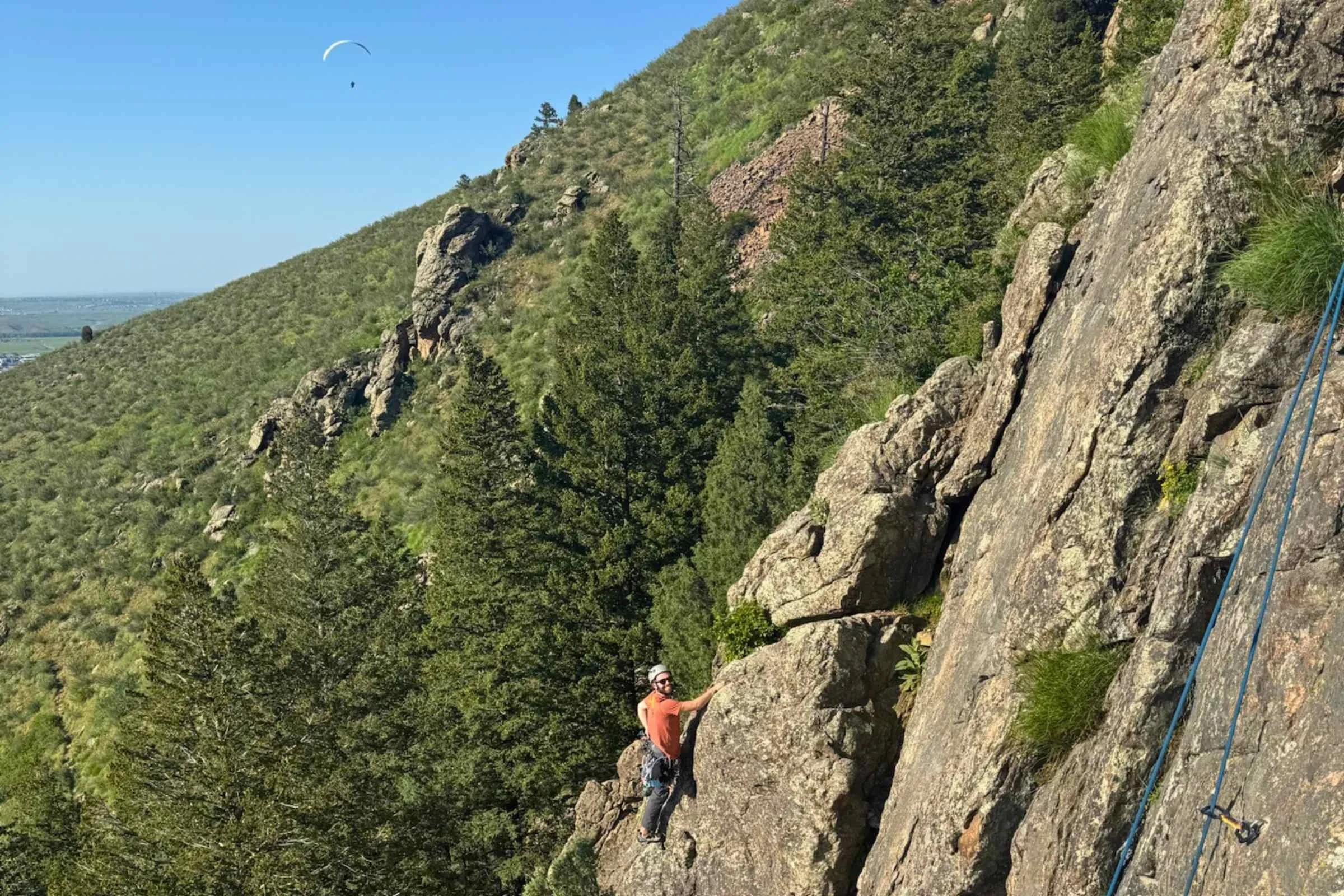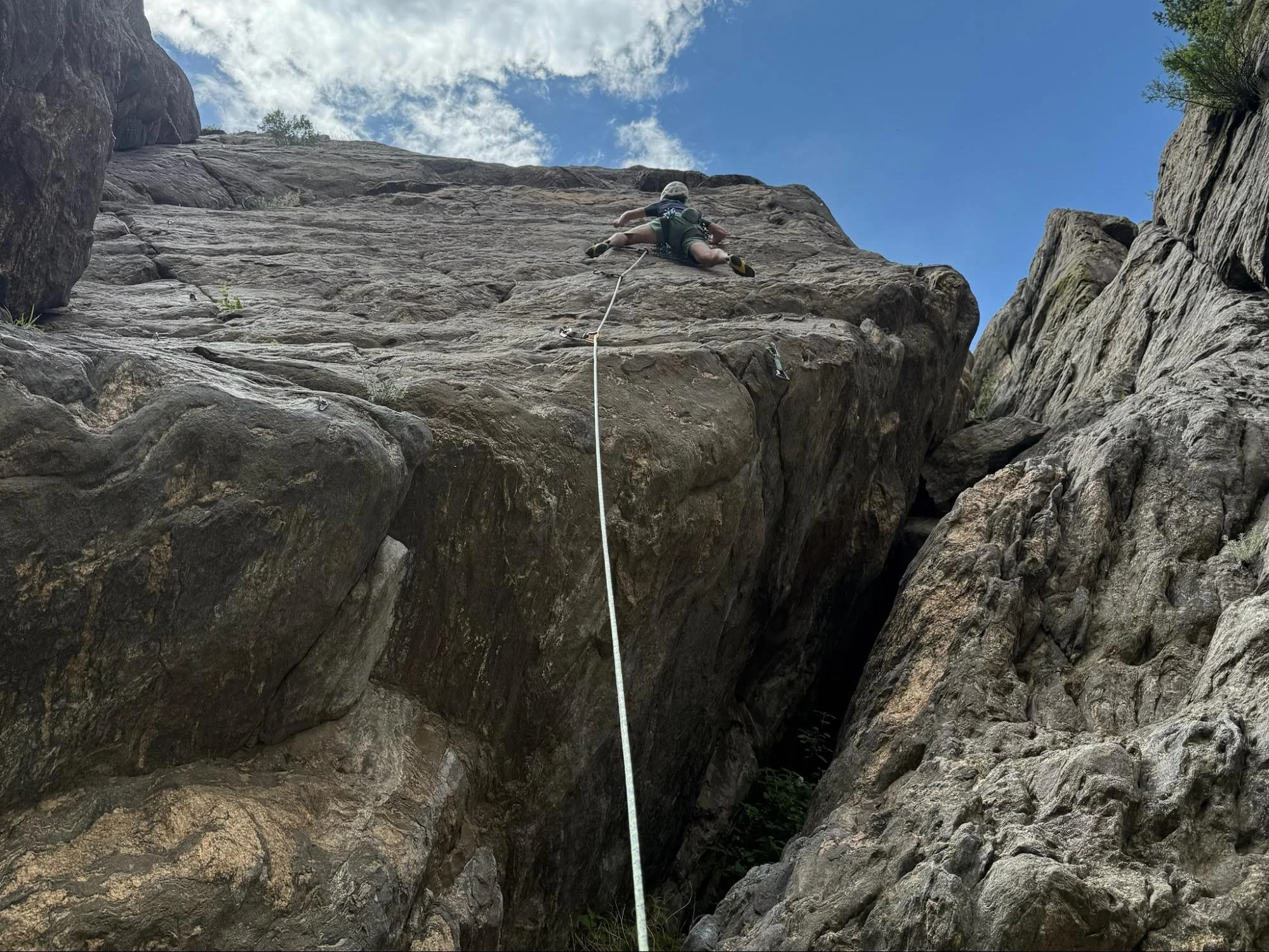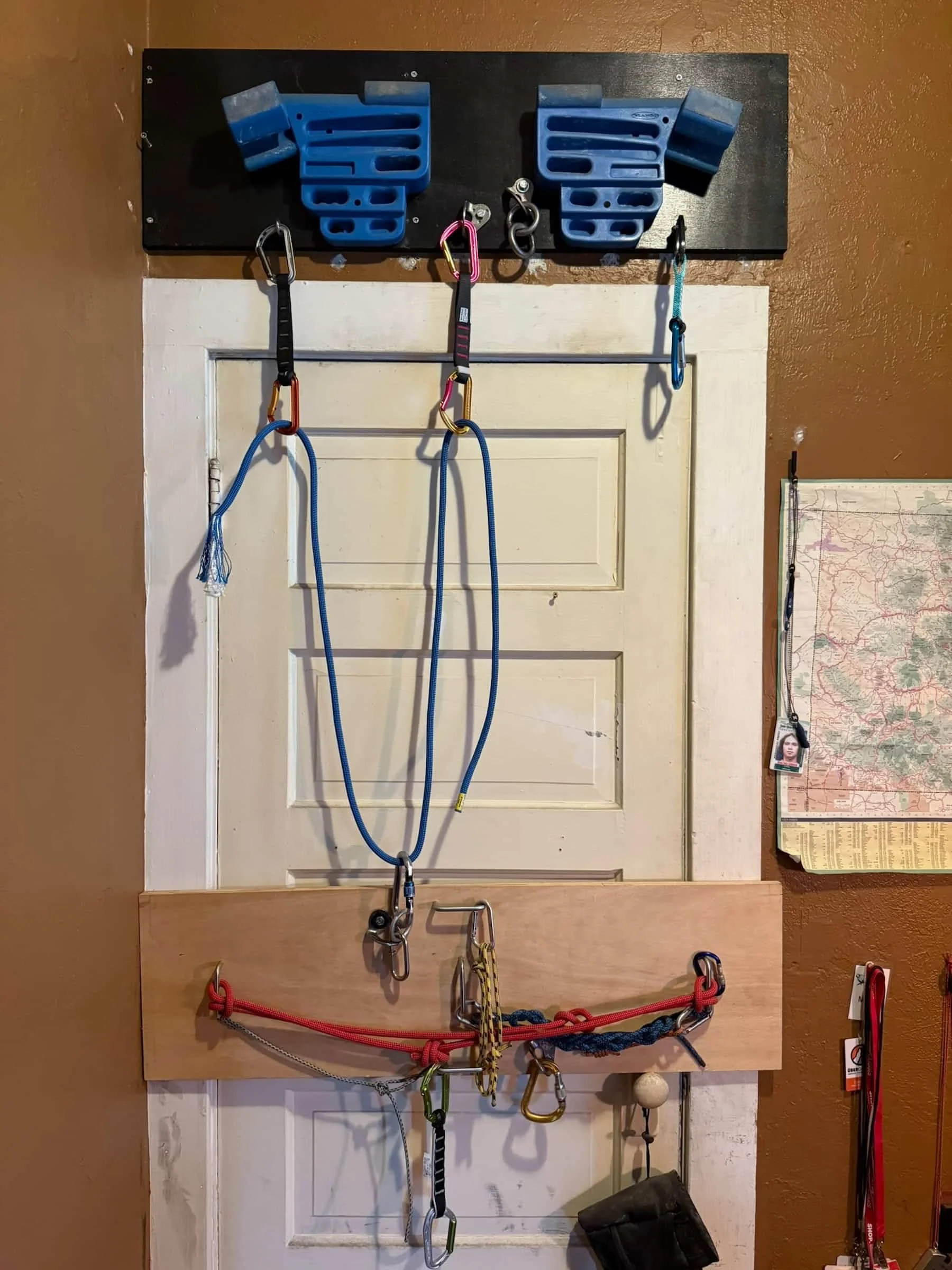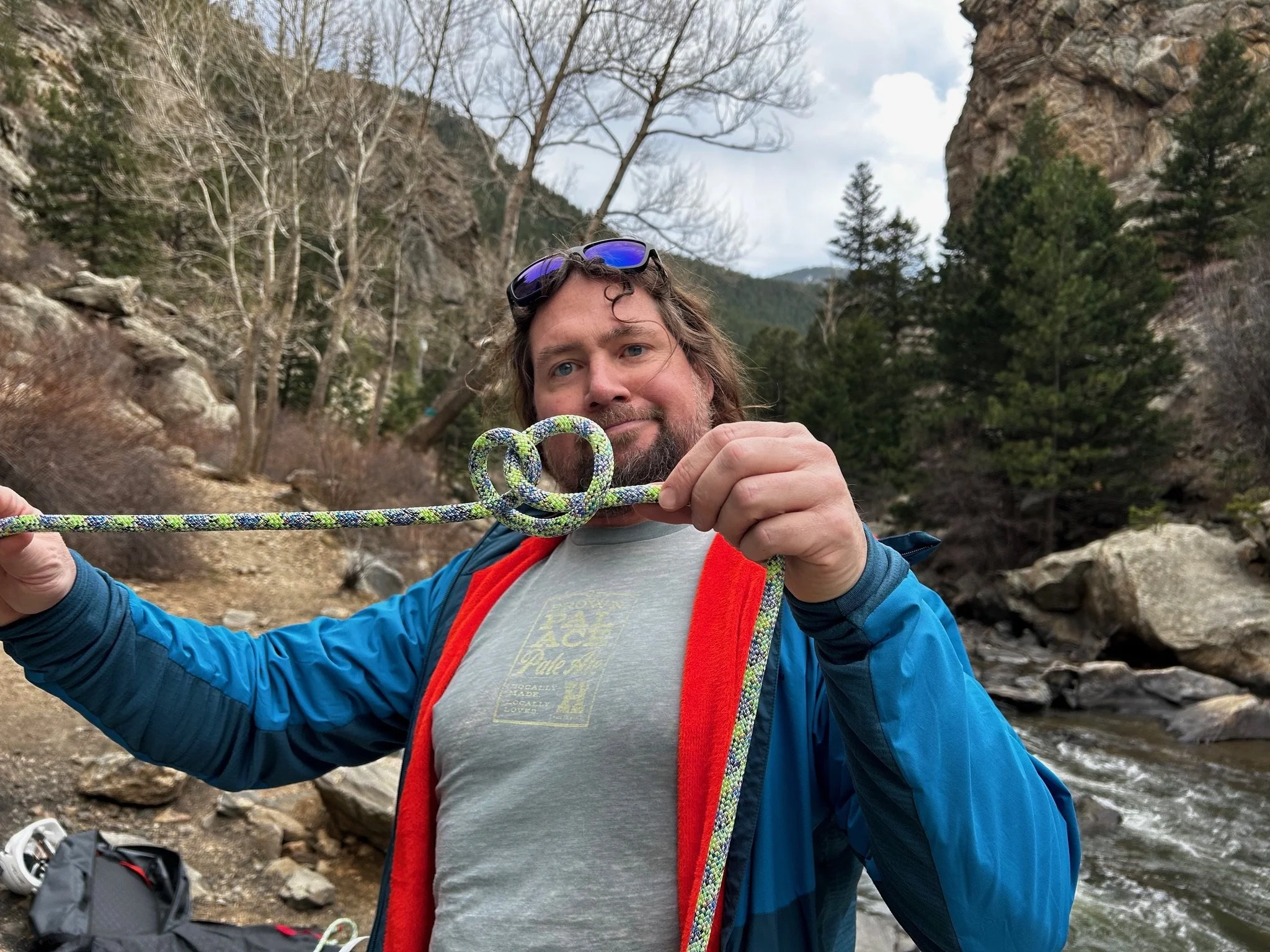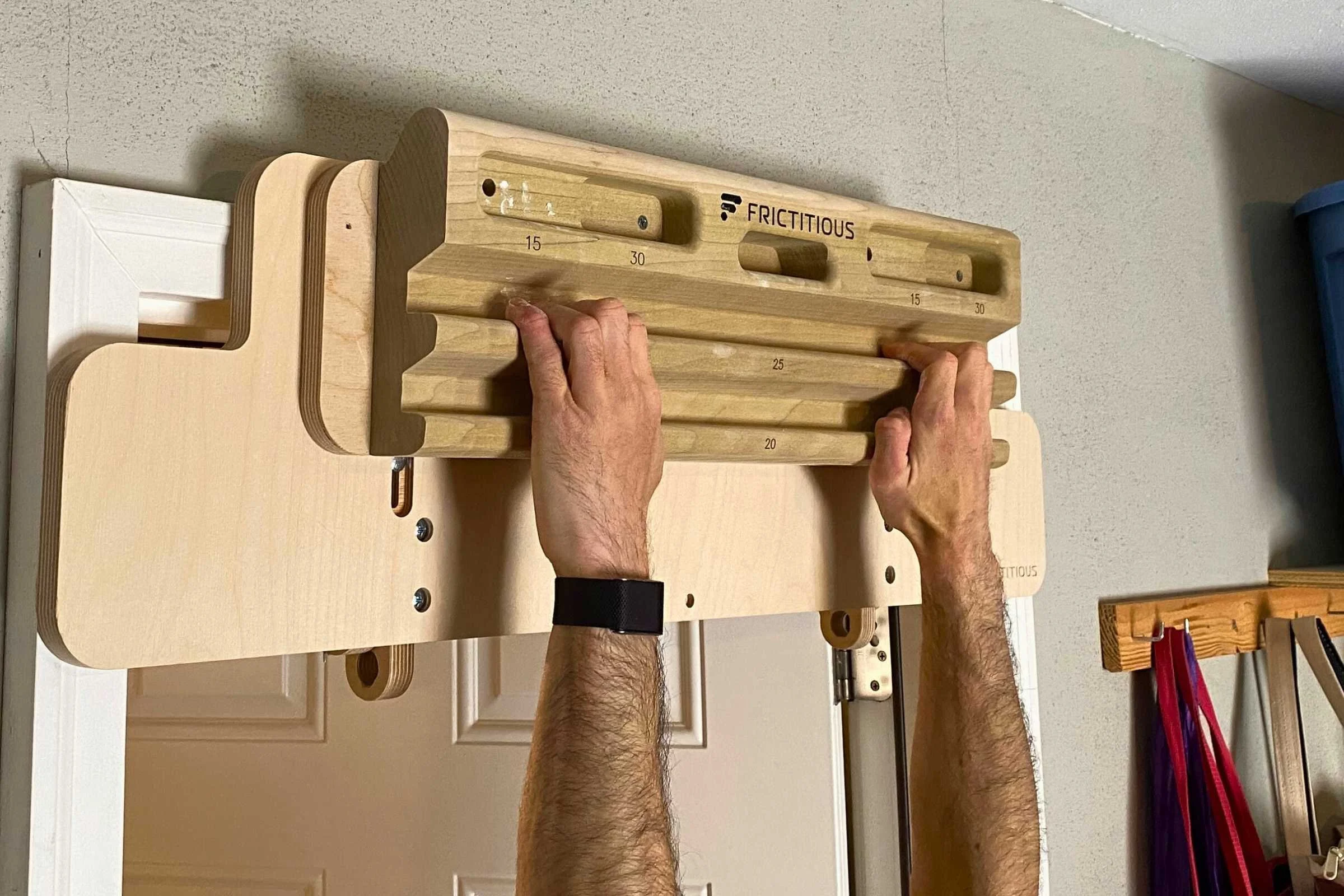Best Climbing Quickdraws of 2025
best quickdraws for different climbers and climbing styles
Quickdraws we tested for this piece.
August 19th, 2025
Home → Gear Reviews → Climbing
In my mind, using quickdraws is like a song lyric: “Clip clip! That’s the sound of the relief!” That’s the relief of clipping in one side of the quickdraw to the rock and the other to the rope to gain more protection on the climb. It’s a sound and feel every climber is familiar with, since almost every climber has used draws while on a rope. They’re one of the most useful and ubiquitous pieces of gear a climber can have whether they’re at the local crag, a big wall, on an alpine climb, ice climb, or multi-pitch climb.
There are a ton of options out there for quickdraws and draws, many of them are good. For this roundup we racked up about 17 great options and chose favorites, relying on our and our climbing buddies' combined decades of experience, testing them in our Front Range backyard into Rocky Mountain National Park, Staunton State Park, Clear Creek, and Boulder Canyons and other places.
In this guide we’ll explain what our favorites are and why, and explain which draws and features are best for different climbers and climbing styles. But first, a note. Climbers and even manufacturers use the terms quickdraws and draws relatively interchangeably, but we consider quickdraws as draws with one carabiner fixed in place and the other end on a loose sling loop. We consider draws as two carabiners clipped to a sling, they’re often called alpine or trad draws.
In this guide, we’ll discuss everything from how the gates and design of carabiners impact a climber’s ability to clip and unclip them while climbing to why dogbone (the webbing connecting carabiners in a quickdraw) lengths and widths matter. We’ll discuss why climbers should have a number of different types of quickdraws and not just the latest rack pack of six identical quickdraws. We’ll also explain how to inspect and determine when it’s time to retire and replace quickdraws.
Related: Best Climbing Carabiners
*No matter what quickdraws you buy, always make sure the carabiners carry the UIAA (International Climbing and Mountaineering Federation) stamp and meet the requirements of its 121 safety standard, and that the dogbones that connect them are certified under the UIAA 104 standard and carry the EN 566 label. Also, always purchase quickdraws and other climbing equipment from reputable sources. There are numerous accounts of people purchasing counterfeit carabiners online and we know of one case over a decade ago where someone stole a bunch of demo pieces (only designed for a show) from a reputable brand and then tried to sell them. Don’t put your life at risk to save a few bucks! Climbing is dangerous and you —and not this gear review website— are responsible for your safety. Make safe decisions and read the instructions before you go!
We create reader-supported, objective, independently-selected gear reviews. This story may contain affiliate links, which help fund our website. When you click on the links to purchase gear, we may get a commission, without costing you an extra cent. Thank you for supporting our work and mission of outdoor coverage for every body! Learn more.
Comparison table
| QUICKDRAW | TREELINE AWARD | GATE TYPE(S) | LENGTHS AVAILABLE | GATE CLEARANCE | STRENGTH MAJOR AXIS CLOSED | STRENGTH MAJOR AXIS OPEN | STRENGTH MINOR AXIS | WEIGHT(S) |
|---|---|---|---|---|---|---|---|---|
| Petzl Ange Finesse | Best overall Read why |
Wire-gate | 23, 26 cm | 23 / 26 mm | S: 20 kN L: 22 kN | S: 9 kN L: 10 kN | S: 7 kN L: 7 kN | 72, 78 g |
| Petzl Spirit Express | Best for sport climbing Read why |
Straight-gate, bent-gate | 11, 17, 25 cm | 24 mm | 23 kN | 8 kN | 7 kN | 89, 95, 104 g |
| Wild Country Astro Trad | Best for trad Read why |
Wire-gate | 10, 15, 20 cm | 22 mm | 24 kN | 9 kN | 7 kN | 66 g, 75 g |
| Wild Country Session | Best for beginners Read why |
Bent-gate, straight-gate | 12, 17 cm | 22 mm | 23 kN | 8 kN | 8 kN | 99 g, 103 g |
| Trango Quantum | Best ultralight for alpine Read why |
Wire, double bent | 10 cm | 19 mm | 20 kN | 7 kN | 7 kN | 52.5 g |
Video: Clipping quickdraws comparison
The winners
There are a lot of great quickdraws out there, and after extensive testing we’ve definitely come to find some are just better than others and deserve to be awarded. These are our top picks for the quickdraws we’re clipping into our harnesses every time we look at that big, beautiful wall of geologic history in front of us.
Best overall climbing quickdraw: Petzl Ange Finesse
Gate type: Wire-gate
Lengths available: 23, 26 cm
Gate clearance (top/bottom): 23 / 26 mm
Strength major axis (closed): S: 20 kN L: 22 kN
Strength minor axis (closed): S: 7 kN L: 7 kN
Weight: 72, 78 g
What we liked: Great at everything we clipped it with, wide dogbone, light
What we didn’t like: Dogbone wasn’t as thick as other options for grabbing.
When it comes to picking a “best overall” of any gear, we have to look at versatility. Which thing fits the most capabilities, best. In this case, the best quickdraw is the Petzl Ange Finesse. It’s a winning combination of everything most climbers want in a quickdraw no matter their discipline. It’s lightweight, has a wide dogbone to grab onto, a keylock nose that’s pretty much impossible to snag on anything, and it comes in multiple dogbone lengths (10 and 17 cm) and carabiner sizes.
Petzl Ange Finesse
The Petzl Ange Finesse in action.
All of these factors make it an ideal quickdraw for sport climbers, trad and alpine climbers, and ice climbers. Our testers appreciated the ease of clipping in on the unique MonoFil gates on both sides of the quickdraw. And though our testing model had both the large and small Ange carabiners on it, no one complained about the small carabiner being too small to handle.
Is this the only quickdraw we’d keep on our rack? No, but if we were building out our dream rack for climbing throughout the year, we’d definitely have four to six of these on our harness.
Best sport climbing quickdraw: Petzl Spirit Express Quickdraw
Gate type: solid, one straight, one bent
Lengths available: 11, 17, 25 cm
Gate clearance (top/bottom): 24 mm
Strength major axis (closed): 23 kN
Strength minor axis (closed): 7 kN
Weight: 89, 95, 104 g
What we liked: Wide, thick dogbones; great carabiner gates, multiple dogbone lengths
What we didn’t like: bolt-end carabiner isn’t as free as other options
The award for best quickdraw for sport climbing was a hard choice and we considered a number of excellent quickdraws for this award, including the Black Diamond Hotwire and Hotforge Hybrid quickdraws, the Mammut Crag Keylock Wire Indicator quickdraw, and the Petzl Djinn Axess quickdraw, and the Trango Reaction Quickdraw. In the end, the Petzl Spirit Quickdraw edged the rest out due to its lightweight, ease of use, and multiple dogbone lengths.
Petzl Spirit Express Quickdraw
The Petzl Spirit Express Quickdraw.
It’s lighter than the Black Diamond Hotforge Hybrid despite having two solid, keynose gate carabiners, compared to the Hybrid’s one wire and one solid gate carabiner. We also like the knurling on the gate of the bolt side and flat front on the bent gate on the rope side, making it really easy to clip into a rope.
At 24 mm wide, the Spirit also has a wider, thicker dogbone than almost every other quickdraw we tested (the Camp Photon Express had a 25 mm wide dogbone), making it ideal for hangdogging when needed. It also comes in three lengths, 11, 17, and 25 cm dogbones. All this makes for a top pick for a sport climbing quickdraw.
Best trad climbing quickdraw: Wild Country Astro
Gate type: Wire-gate
Lengths available: 10, 15, 20 cm
Gate clearance (top/bottom): 22 mm
Strength major axis (closed): 24 kN
Strength minor axis (closed): 7 kN
Weight: 66 g, 75 g
What we liked: lightweight, color-coded dogbone lengths, carabiners are easy to handle despite being smaller than other options
What we didn’t like: floppy dogbones not ideal for sport climbing, hooknose wiregates could snag on bolt hangers
When considering a pre-made trad quickdraw the Astro from Wild Country, and particularly the Astro Quickdraw 6 Pack Trad, was easily our top pick from among the quickdraws we considered for best trad quickdraw. The dogbones of these extremely lightweight quickdraws are color-coded according to length: red-10 cm, 60 g; green-15 cm, 62 g; and blue-20 cm, 62 g. This makes it really easy to find the proper length quickdraw on the harness when placing trad gear.
Wild Country Astro
Single
6-pack
The Wild Country Astro Quickdraw 6 Pack Trad features quickdraws with three different dogbone lengths, color-coded.
We also noted that though the Astro carabiners are on the smaller side of quickdraw carabiners, they’re still big enough for larger hands as opposed to the carabiners on the Trango’s Quantum quickdraws, which are too small for larger hands to easily operate.
The thin dogbones on the Wild Country Astros are floppier both horizontally and vertically than those of shorter and sport dogbones. This makes it a little harder to place them on sport routes with bolts. But it also makes them more ideal to place on trad protection like cams and nuts to help reduce rope drag.
The six pack retails for $120 (or $20 per quickdraw) and has two of each length. Sold alone, each quickdraw ranges from $23 to $25, which is also a great value.
Best beginner quickdraw: Wild Country Session Quickdraw
Gate type: Solid, one straight, one bent
Lengths available: 12 cm or 17 cm
Gate clearance (top/bottom): 22 mm
Strength major axis (closed): 23 kN
Strength minor axis (closed): 8 kN
Weight: 99 g, 103 g
What we liked: Good value for a hybrid quickdraw, dogbone wide enough to hang on, unique appearance
What we didn’t like: Heritage version doesn’t have different colored quickdraws, not ideal for trad or alpine climbing
The best beginner quickdraw was likely the hardest choice to make. Beginning sport climbers want a good value quickdraw that’s easy to hang on to, easy to clip, and easy to determine which end to clip. For this category we considered many of the same quickdraws as we considered for the Best Sport Climbing Quickdraw, including the Black Diamond Hotwire and Hotforge Hybrid quickdraws, the Mammut Crag Keylock Wire Indicator quickdraw, and the Petzl Djinn Axess quickdraw. All are great options, honestly. But in the end, we liked the Session from Wild Country for beginners the most due to its relatively wide dogbone, unique appearance, and price.
Wild Country Session Quickdraw
Single
6-pack
The Wild Country Session Quickdraw in action. It’s a great pick for value, features, and looks.
At $20, they’re a good value, lighter than some of the options we considered, and have some more features found on more expensive quickdraws, including a bentgate rope carabiner. The straight gate on the top is easy to distinguish from the bentgate on the bottom and it’s easy to clip into each end thanks to the keylock noses on each end.
The gates have a solid, snappy feel and noise when let loose, reassuring more novice climbers that they’re clipped in and safe and the dogbones are thick and wide enough to grasp onto when taking a rest or projecting.
In 2025 they’re offered in two fantastic, unique retro-ish designs as well. One we call hulk, with green and purple components throughout, and the other we call ’80s Trans Am (they call it Heritage) with purple, red, orange and yellow stripes on the dogbone. This helps them stand out in a sea of other carabiners and makes them easier to distinguish and collect after a day of climbing with buddies when everyone’s gear inevitably gets mixed up with others’.
Best ultralight quickdraw for alpine: Trango Quantum Quickdraw
Gate type: Wire, double bent
Lengths available: 10 cm
Gate clearance (top/bottom): 19 mm
Strength major axis (closed): 20 kN
Strength minor axis (closed): 7 kN
Weight: 52.5 g
What we liked: Ultralight, dogbone just long enough to fit full palm around
What we didn’t like: Small carabiners are harder to operate with big hands/gloves, sling loop is small, not allowing for much movement
When it comes to alpine climbing, fast and light is the key. So weight trumps just about everything else. The 10 cm Quantum quickdraw from Trango has a claimed weight of 52 grams, easily making it the lightest quickdraw we tested and only about 6 more grams than the Edelrid Nineteen G 10 cm quickdraw, which we didn’t test.
Trango Quantum Quickdraw
Single
6-pack
Despite its diminutive size, it’s a fully featured quickdraw with a captive carabiner and a sling carabiner on the dogbone. The carabiners themselves are small enough to fit inside some medium and large-sized carabiners. This obviously reduces weight significantly but also makes it harder for people with larger hands and those wearing gloves to manipulate them. Still, if lightness is paramount to your climbing, these are an ideal option.
Most durable quickdraw for projecting: Edelrid Bulletproof Quickdraw
Gate type: Bent-gate, straight-gate
Lengths available: 12, 18 cm
Gate clearance (top/bottom): 20 mm
Strength major axis (closed): 24 kN
Strength minor axis (closed): 8 kN
Weight: 124 g
What we liked: Big, fat dogbones for hangdogging; steel insert makes for a long-lasting quickdraw
What we didn’t like: Heavier than other options, more expensive than most other options
Got a project you've been working on? The Edelrid Bulletproof is a quickdraw that lives up to its name. With a steel insert on the bottom, rope side of the quickdraw, Edelrid’s Bulletproof is the best quickdraw to place on the first bolt of a sport route, the anchors of a route, or when you’re pushing at your limit and projecting a move.
The steel insert where the rope rubs will withstand more years of heavy use than the typical quickdraw carabiner made of aluminum, and its rated for falls up to 27 kN along its spine—only the Trango Vector had a higher rating at 28 kN. That makes Edelrid's Bulletproof the best quickdraw for working projects and our winner for best durable quickdraw.
Edelrid Bulletproof Quickdraw
With the steel insert on the rope carabiner, the Edelrid Bulletproof Quickdraw should outlast all other quickdraws.
However, the 18 cm dogbone on the Bulletproof we tested is beefy, wider, and just long enough to grasp with two hands—ideal if you’re pumped and need to grab something other than the rock to rest on for a minute or two, or if you need to grab it to jug yourself back up to the bolt. The dogbone and sling end are also stiff enough to make clipping into bolt hangers easy without flopping around too much.
At $37 retail, it’s definitely the most expensive quickdraw we tested. But with the steel insert and overall beefiness of the quickdraw, we think it’s worth the investment for the right circumstances and it should last longer than almost any other quickdraw in your arsenal.
Best extendable alpine draw: Trango Quantum Alpine Draw 60 cm
Gate type: Wire
Lengths available: 60 cm
Gate clearance (top/bottom): 19 mm
Strength major axis (closed): 20 kN
Strength minor axis (closed): 7 kN
Weight: 61.7 g (single), 247 g (4 piece)
What we liked: Lightest of its type, color-coded carabiners
What we didn’t like: Small carabiners hard for bigger hands to use
When it comes to alpine draws, many climbers will make their own and use "DIY draws" with a sling and two carabiners. However, some companies, like Trango, Black Diamond, DMM and Wild Country offer pre-made alpine quickdraws. We were impressed with theTrango Quantum Alpine Draw for a number of reasons.
Trango Quantum Alpine Draw 60 cm
Single
4-pack
The Trango Quantum Alpine Draw, as we’d carry it on our climbing harness.
First off, at 62 grams, the Trango Quantum Alpine Draw is the lightest alpine draw we’ve seen with a 60 cm sling. Also, unlike the Black Diamond MiniWire Alpine, it comes with two different color carabiners, making it easier to keep track of which side of the draw you connect to the rope and the protection you place.
When placing trad gear, climbers are usually clipping into slings on cams or the round cables on nuts and hexes. These are less likely to cause damage to a carabiner than the hard edges of a bolt hanger, so it’s not as important to keep track of which end you’re clipping into with an alpine draw. But it is still good to keep track of in case you ever clip into a bolt or piton and fall on it.
At $28 per draw, the Quantum is within the realm of prices for other alpine draws, and we think the features and benefits of this system make it a good choice for alpine draws.
Best sport climbing set: Trango Sport Climbing Package
Gate type: Wire-gate
Lengths available: 12, 60 cm
Gate clearance (top/bottom): 19 mm
Strength major axis (closed): 22 kN
Strength minor axis (closed): 8 kN
Weight: 67 g (single), 914 g (12 piece)
What we liked: Great all-in-one package, good value, easy to grasp carabiners
What we didn’t like: No double-length sling option, thin dogbones more suited for trad, locking carabiners are all the same color
Sometimes, it's easier getting a single sport climbing set that includes everything you need. For $230, Trango put together this great sport climbing kit, which has everything you need to get into leading sport routes for about $30 less than when buying everything separately.
The Trango Sport Climbing Package includes their Quickdraws and React screwgate locking carabiners. The kit also comes with two 60 cm slings with React screwgate locking carabiners on each end, for building and equalizing sport anchors.
Though the Phase Quickdraws aren’t a top pick, they’re great wiregate quickdraws with snappy action and a good feel in hand—they have thinner dogbones more at home in trad environments though.
If you’re looking to get everything at once or build a new sport climbing kit quickly, this is a great option. If you’re climbing longer sport routes, however, you may need to invest in a few more quickdraws in case a route has more bolts.
Trango Sport Climbing Package
Best affordable quickdraw Cypher Firefly II
Gate type: Wire
Lengths available: 11, 16 cm
Gate clearance (top/bottom): 22/ 22 mm
Strength major axis (closed): 22 kN
Strength minor axis (closed): 7 kN
Weight: 74, 76 g
What we liked: lightweight, great value, good for trad
What we didn’t like: thin dogbones, harder to grip than some
The majority of quickdraws we tested were between $20 and $30 apiece—sometimes slightly less when combined in a rack pack of six or more. The Cypher Firefly II retails for $13.50 per quickdraw and comes in a rack pack with a Firefly II locking carabiner for just $80.99 at time of writing (July 2025). The author has bought rack packs of these draws numerous times over the years—most recently in late 2024 and is finally retiring some from a pack he bought about 10 years ago.
Cypher Firefly II
The Cypher Firefly II is a great low-cost option—particullary for alpine and ice climbers.
With 11mm-wide slings, they’re best suited for trad climbing, but are still great for those wishing to save money on a basic sport rack. The thin dogbones make them easy to rack and they take up less space on the harness than quickdraws with thicker dogbones. Still, the thin dogbones mean they’re not comfortable or ideal for hangdogging on when working through the toughest part of a route.
The flatter nature of the hooknose seemed to make it a little easier to snag the carabiners on the flat edges of a bolt hanger than many of the other hooknose gates we tested. This can make cleaning a hard sport route a little more difficult, but we didn’t find it a deal breaker. The shinier finish and lack of ridges on the carabiners made them a little slicker to handle than powder-coated carabiners and those with more featured spines, but in the end these are a great value and worth considering.
Other quickdraws we tested
Black Diamond Hotwire Hybrid Quickdraw
Gate type: Wire, straight
Lengths available: 12, 16 cm
Gate clearance (top/bottom): 27 mm
Strength major axis (closed): 24 kN
Strength minor axis (closed): 8 kN
Weight: 94 g
A very good option for sport climbing, this model was edged out by the Petzl Spirit Express with its lighter weight, wider dogbones with more available lengths, and keynose gates on both carabiners.
Black Diamond Hotwire Hybrid Quickdraw
Single
6-pack
The Black Diamond Hotwire Hybrid quickdraw has one solid gate and one wiregate carabiner.
Gate type: Wire, straight
Lengths available: 12, 16 cm
Gate clearance (top/bottom): 27 mm
Strength major axis (closed): 24 kN
Strength minor axis (closed): 8 kN
Weight: 94, 99 g
Another decent option for sport climbing but this is still heavier than the Petzl Spirit Express. That’s despite two wiregate carabiners and a narrower dogbone. Also, it has less dogbone option lengths.
Black Diamond Hotwire Quickdraw
Single
6-pack
The Black Diamond Hotwire is a decent choice for a sport quickdraw, but its carabiner lacks bentgates and it has a narrower dogbone than other options.
Gate type: Wire, straight
Lengths available: 12, 16 cm
Gate clearance (top/bottom): 23 mm
Strength major axis (closed): 24 kN
Strength minor axis (closed): 8 kN
Weight: 73, 76.5 g
These lightweight wiregate quickdraws are designed more for sport and multi-pitch climbing, thanks to their lightness and thinness. But in the end we found the Wild Country Astros to be a little lighter and appreciated their color coding for the lengths of the dogbones.
Black Diamond Litewire Quickdraw
Single
6-pack
The Lightwire is a decent, lightweight carabiner, but there are lighter options at similar costs.
Gate type: Solid, straight/ bent
Lengths available: 12, 18 cm
Gate clearance (top/bottom): 21/ 25 mm
Strength major axis (closed): 22 kN
Strength minor axis (closed): 7 kN
Weight: 91, 97 g
We tested the 18cm version of the Photon Express KS Janja and found it a decent quickdraw but thought others were better. The sling end of the quickdraw was looser than most, making it floppier than we prefer. We also found that the rubber securing the rope end of the carabiner was softer than others, which worries us that it is less durable than other carabiner keepers we tested.
Camp Photon Express KS Janja
Single
6-pack
We’re wary that the carabiner keeper on the rope end of the Photon isn’t as durable as other options and found the open end of the sling was looser than we would have liked.
Gate type: Straight, wire
Lengths available: 15. 24 cm
Gate clearance (top/bottom): 17 mm
Strength major axis (closed): 22 kN
Strength minor axis (closed): 7 kN
Weight: 71, 79 g
This wiregate quickdraw has a large open loop making it pretty floppy, and the stiff portion of the dogbone is pretty short making it hard to grasp onto.
Metolius Bravo II Wiregate
Single
5-pack
The Metolius Bravo II quickdraw wasn’t among our top choices.
Gate type: Wire
Lengths available: 15.24 cm
Gate clearance (top/bottom): 21 mm
Strength major axis (closed): 22 kN
Strength minor axis (closed): 7 kN
Weight: 86 g
This is a really unique, expensive quickdraw that we wanted to like better. However, despite the captive carabiners on each end of the dogbone, it still feels floppy in hand and in placing on bolt hangers. We also noticed that the steep angle between the nose and spine made it difficult to place and remove on tight hangers. We might like this quickdraw more if the rope end was not just captive but also tight.
Metolius Captive
We wanted to like the unique Metolius Captive carabiner more but wish the captive carabiners were less floppy on the dogbone.
Gate type: Keylock Wire
Lengths available: 10 cm
Gate clearance (top/bottom): Not stated
Strength major axis (closed): 24 kN
Strength minor axis (closed): 8 kN
Weight: 106 g (single)
We considered these great quickdraws from Mammut for best affordable and best sport quickdraw–they’re ideal for each category but were barely edged out in each category. We liked the dogbones and that the protected hooknose on the wiregate wasn’t prone to catching on rope. The beveling and notching on the straight gate made placement on hangers easy and precise, and the loop end of the sling allowed for the right amount of movement on the hanger.
Mammut Crag Keylock Wire Indicator Quickdraw
The Mammut Crag Keylock Indicator was a strong contender for the best sport climbing quickdraw.
Gate type: Wire
Lengths available: 12 cm
Gate clearance (top/bottom): 19.5 mm
Strength major axis (closed): 21 kN
Strength minor axis (closed): 7 kN
Weight: 28 g
The Mammut Sender quickdraws are another great choice for a lightweight, sport, and alpine-friendly quickdraw. The wide dogbones are easy to grab and the wiregate carabiners feel comfortable in hand. However, the unprotected hooknoses were more prone to catching on hangers than some others we tested. Also, one tester noted that the gate action on these wasn’t quite as snappy as others we tested, which meant that her primary climbing partner, who is deaf, is less likely to feel when she clipped into the rope.
Mammut Sender Wire Quickdraw
The Mammut Sender Quickdraw was edged out by Petzl’s Ange Finesse and others.
Gate type: Bent-gate
Lengths available: 11, 17, 25 cm
Gate clearance (top/bottom): 27 mm
Strength major axis (closed): 23 kN
Strength minor axis (closed): 8 kN
Weight: 103, 113, 121 g
The Djinn Axess from Petzl is another great, affordable choice from Petzl. But against its other models and the other models we tested, it got edged out. The keylock carabiners are well designed and easy to use, but the Petzl Spirit quickdraws just edged it out with the lighter weight and wider dogbones. We also noticed that the bolt side carabiner had an audible squeak from day one. Not a dealbreaker, but not as smooth as other quickdraws we tested.
Petzl Djinn Axess
Single
6-pack
The Petzl Djinn Axess is the company’s most affordable carabiner, but others offer better value.
Gate type: Straight, bent
Lengths available: 12 cm
Gate clearance (top/bottom): 26 mm
Strength major axis (closed): 25 kN
Strength minor axis (closed): 8 kN
Weight: 113 g
Another great contender for best sport quickdraw, testers liked the beefiness of this model with its thick, square gates and the dogbones that were easy to grab onto. However, at 119 grams it was the second heaviest model we tested—behind the Edelrid Bulletproof, which has a steel insert.
While it’s a durable, great quickdraw we wouldn’t want to fill our sport rack with these for long days and multi-pitch routes. We’re also a little perplexed by Trango’s choice of colors for the carabiners. A black carabiner (with a green gate) on the rope side goes against the design of most quickdraws—even Trango’s other quickdraws—that have a grey or black carabiner on the bolt side and a colored one rope side.
Trango Reaction Quickdraw
Single
6-pack
The Trango Reaction Quickdraw is a burly sport quickdraw, that’s easy to use, but also among the heaviest we tested.
Gate type: Wire-gate
Lengths available: 12 cm
Gate clearance (top/bottom): 19 mm
Strength major axis (closed): 22 kN
Strength minor axis (closed): 8 kN
Weight: 67 g
A great, lightweight quickdraw with a narrow sling. We’d be happy to carry 10 or 12 of these on our rack for multi-pitch days and as part of a mix of draws for a trad rack. We think it’s a really good choice, especially as part of the Trango Sport Climbing Package, but the Cypher Firefly II offers a better value when bought separately for a climbing rack.
Trango Phase Quickdraw
Single
6-pack
The Phase is an ideal starter or alpine quickdraw but there are better values out there.
Gate type: Bent wire
Lengths available: 12, 24 cm
Gate clearance (top/bottom): 30 mm
Strength major axis (closed): 22 kN (sling), 30 kN (carabiner)
Strength minor axis (closed): 8 kN
Weight: 95 g, 130 g
This versatile, bentgate wiregate quickdraw is a decent, durable choice for a lot of conditions, including snow and ice. It has enough of a dogbone to hang off of while projecting a route, but it’s not as ergonomic as some wider dogbones. But at 95 grams it’s heavier than the Petzl Spirit Express and other leading sport quickdraws.
Trango Vector Quickdraw
Single
6-pack
A durable sport climbing quickdraw, the Vector from Trango is an easy to use quickdraw.
What to look for in a climbing quickdraw
Different styles of quickdraws.
Before we bolt into quickdraws, let’s rack up some knowledge and get an anchor on what they are and why climbers need and love them.
The origin of the modern quickdraw likely dates back to the 1970s when legendary Colorado climber Jim Erickson fixed two carabiners to short lengths of webbing rather than just loose, short slings. He credits climbing partner Duncan Ferguson with the name. Since then, they’ve evolved somewhat, but quickdraws still have three main features: two carabiners and webbing in between.
A lot of climbing safely is about climbing efficiently. Quickdraws and draws are an excellent example of how companies and climbers have worked to make climbing more efficient. Each element of the best quickdraws are designed to make it easier and quicker to clip them to the rock and rope to protect the climber as they go up.
The webbing, which is sewn on many pre-made quickdraws—especially those for sport climbing, is called a dogbone and it serves a few important purposes. It helps orient the carabiners for clipping to the rope and rock correctly and it allows the rope to move as freely as possible while the climber is climbing and lowering. They can also serve as a place for a climber to grab and hangdog off to rest or readjust on a hard climb.
Most modern dogbones have two different sides. One is a sling with a loop, while the other is usually set tightly on a carabiner with a rubber or plastic collar to keep it fixed in place.
The sling end is intended to connect to stone via the steel bolts you’re climbing on while the fixed carabiner is designed to clip to the rope. That’s why many climbers keep the refrain “rubber to rope” in mind when using quickdraws. However, it’s pretty easy to conflate rubber to rope with rubber to rock. So we like to say: “Rubber to rope and sling to steel and stone.” The main thing is this orientation allows for the most freedom of movement on the rope, reducing drag and the likelihood the draw could somehow unclip in a fall or because of any wild movements.
The carabiners at either end of the dogbone serve distinct purposes as well. In almost all models we tested the colors of the two carabiners on a quickdraw were different. In most cases the more colorful carabiner of the two is on the fixed end of the webbing and intended for the rope. The other end is usually a black or gray aluminum color.
There’s more to this, but at a minimum we recommend at least buying quickdraws or rack packs (usually 5 to 8 quickdraws in a set) that have the two differently colored carabiners connected with a dogbone with a fixed end and a looser end.
On the left both quickdraw carabiners have solid, straight gates for clipping into a bolt. On the top right, there’s a carabiner with a solid, bentgate. On the bottom right, there’s a carabiner with a wiregate.
Gate style (straight, bent, wire, keylock, solid)
There are many styles of gates for carabiners on a quickdraw. While each gate type should work on either end of a quickdraw, climbers might have a preference on certain types. We’re going to explain the gate types and styles, and why they matter, here but if you’d like to learn more about why gates are made the way they are and why, check out our guide to the best climbing carabiners.
In regular carabiners, some gates are solid pieces of metal while some are made of wire. Some gates are straight and others are bent. The straight gates are generally designed for clipping into bolts and anchors. The bent gates are designed to make it easier to clip into a rope while holding the spine.
Wiregate carabiners are generally lighter than solid-gate carabiners and the design of wiregate carabiners make them less likely to flutter than solid-gate carabiners, which could feasibly (unlikely) allow a gate to open during a fall or event when the quickdraw is moving quickly and erratically like in an unexpected gale.
Most quickdraws use the same type of carabiner on each end, but some will opt for a bent gate on the rope end and a straight gate on the stone side. In some cases, they’ll put a solid gate on the loose, sling side of the quickdraw and a wiregate on the fixed rope side. This helps reduce the likelihood of the bolt catching on the hook nose of a wire carabiner.
The grey carabiner on the bottom has a keylock nose and the blue carabiner on the top has a hooknose.
Nose
The nose of the carabiner is where the gate rests when closed, making the carabiner stronger, and when stressed during a fall it's designed to lock the gate in place. There are two main styles of noses on a carabiner: keylock and hooked.
Keylock carabiners are found on many solid-gate carabiners. Some solid-gate carabiners use a pin on the gate and a hook-nose design. Most wiregate carabiners use a hook nose design. The unique Petzl Ange carabiners are considered a wiregate carabiner but have a keylock-type nose, thanks to a single, thick wire with a bulbous end.
The hook nose design is easier to make as keylock noses and gates require more precise forging and tolerances, making them more expensive. However, the hook on the nose is more susceptible to snagging on a rope or bolt. To help reduce this, manufacturers continue to refine and revise their hook designs and some have made what they called clean noses to reduce any possibility of snagging on ropes and other gear.
In field testing quickdraws, we didn’t notice any models that experienced repeated snagging on a hook nose. Testing at home we were able to figure out ways to snag hooks on narrow slings and bolts. Still, we think manufacturers are continuing to refine these designs to make snags less likely on hook noses.
Sling/dogbone material and width
The slings or dogbones that connect draws together are impressive pieces of woven and sewn materials. Made of nylon, polyester, or Dyneema, they’re capable of withstanding the 22kNs (kilonewtons) of force, which is equivalent to just under 5,000 pounds, or the weight of two NFL teams squaring off on the field.
Wider slings are usually made of nylon or polyester and are usually intended for sport climbing. The width of the sling makes it easier to clip and to grab and hang off of when sport climbing. Some, like Petzl’s Ange Finesse and Spirit Express, taper towards the sling end, making them more ergonomic.
Narrow slings and dogbones are made of Dyneema or an equivalent material. They’re suitable for sport climbing but are also used for alpine, trad, big wall, mountaineering and ice climbing.
The sling end of a quickdraw allows the carabiner to move more freely. The captive end keeps the carabiner from rotating around and usually has a rubber or plastic piece that is either inside or outside of the sling material to keep the carabiner properly oriented on the rope. We found that quickdraws intended primarily for sport climbing tend to have an external carabiner keeper whilst those intended for trad and alpine climbing had an internal carabiner keeper.
The difference between the shortest dogbones and longest dogbones tested is significant.
Dogbone/Sling Length
The length of the dogbone also helps determine its best use. The majority of dogbones we tested were in the range of 12 to 15cm long, but some are as long as 25cm. These are the most usual sizes used in sport climbing as they’re long enough to easily grasp and allow for rope movement but not so long that they cause an issue on your harness or feel floppy when clipping in.
If you’re just buying your first set of quickdraws, we’d recommend getting a rack pack or two of quickdraws with 12-15cm dogbones, like the Wild Country Session pack or the Petzl Djinn Axess. They fit most hands well and aren’t so long that they’ll get floppy. However, we’d also recommend that even when building out your sport rack to get or make a couple of alpine draws in case you’re climbing routes that aren’t bolted in a relatively straight line and want to reduce rope drag or the likelihood that you’ll swing in a fall.
The shortest we tested was the 10cm dogbone on the Trango Quantum quickdraw, which was so short both sides of our hand touched the carabiners when we gripped it. The longest we tested was the 20cm dogbone on the blue Wild Country Astro quickdraw that’s part of the Astro Quickdraw Trad - 6-Pack.
Most alpine and trad draws, like the Trango Quantum Alpine Draw use slings rather than the dogbones that quickdraws do. Most pre-made draws use a 60cm sling, but alpine and trad climbers may make some with a longer sling if they choose. With these draws climbers can make them shorter for racking on the harness by doubling them on the carabiners. They can then use them that way or fully extend the sling.
An extended sling means you’ll fall farther if you do fall, but an extended sling does a number of important things. If you’re climbing a sport route with bolts that zig zag up the rock wall or climbing over a bulge or roof, a long sling will help keep the rope straighter, reducing drag. Similarly, they’re ideal for trad and alpine climbing where pro placement isn’t necessarily in a straight line. This is because the reduced rope drag means any placed cams or nuts won’t see much tugging from the rope, which can cause them to walk and move out of position.
Weight vs. durability tradeoff
Our “lab” testing included testing stated manufacturer weight vs. actual weight.
There isn’t necessarily a direct tradeoff between the weight and durability of quickdraws. The Dyneema used in dogbones is among the strongest, lightest materials in the world and is very durable. Nylon and polyester dogbones are heavier and usually have more material, but may be more susceptible to wear.
Smaller, lighter carabiners have less material in them and may wear faster than larger carabiners, but the gate mechanisms are the same and will wear roughly the same.
Sport climbers don’t worry about weight as much as trad, alpine, and multi-pitch climbers. That’s because most sport routes are only up to 35-40 meters long and climbers can relax between routes. So a sport climber is more likely to be fine with a heavier, more durable quickdraw with a wider dogbone and carabiners with solid gates. A trad or alpine climbing will opt for lighter carabiners and dogbones on quickdraws and draws because they’re carrying more gear and are likely out for a longer day on the rock or mountain.
Carabiner size and clipping ergonomics
Carabiners used on quickdraws are usually between medium to small in size. They’re not usually as big as the common HMS carabiner used for connecting belay devices to the harness or setting up master points.
When choosing quickdraws, make sure you’re comfortable with the size of the carabiner in your hand and that you can easily compress the gate with a finger with your palm against the spine of the carabiner. Most hands are fine with handling the majority of the normal-sized carabiners used in quickdraws.
Smaller carabiners used in some ultralight quickdraws, like the Trango Quantum quickdraws and alpine draws, are too small for those with larger hands and become cumbersome for them to operate, especially in tough, tense moments of climbing.
In our testing we found that a steeper, sharper angle on the top of an offset-D carabiner, like the Metolius Captive Quickdraw, was a little harder to clip into bolts with less clearance around them.
Gate tension and opening size
For the UIAA to certify a carabiner under its 121 safety standard, the gate must open to at least 15mm. That’s larger than the thickest climbing rope we tested, the 10.5mm thick DynaGym rope. Generally, a larger gate makes it easier to connect a carabiner to climbing gear. However a too-large gate opening can make handling a carabiner with one hand unwieldy.
The carabiners used on quickdraws were generally over 20mm when open. However, even with smaller open gates we didn’t have too much trouble clipping ropes or bolts.
Gate tension is a little harder to measure, but all of the new quickdraws we tested felt pretty snappy. Heck, even some of the retired quickdraws we use around the house and office for hanging gear still have snappy gates after five or more years of use.
From left to right quickdraws ideal for sport, trad, alpine climbing, and projecting climbs.
Use case (sport, trad, alpine, projecting)
Depending on what type of climbing you’re doing or planning to do, you’re going to want different quickdraws and draws. Basically for sport climbing and projecting, solid gates and thick, beefy dogbones that are easy to grab and hang off of are ideal.
For trad and alpine climbers, the focus is on weight and versatility. Lighter wiregates carabiners and longer dyneema slings are ideal.
Types of quickdraws explained
While quickdraws and draws are somewhat interchangeable for different types of climbing, most climbers will want to have at least a few of each kind no matter what they’re doing. A quickdraw can come in handy at some points on a trad route where you don’t want a sling to catch on something. A sport climber might want to deploy an alpine draw at full length to reduce rope drag on a route with zig-zagging bolts or to redirect climbers on a route.
Sport quickdraws
Sport quickdraws are the most common quickdraws you’ll find. They have a carabiner fixed in place at one end and a loop at the other, allowing that carabiner to move more freely. Length is measured in terms of the dogbone, and they come in lengths ranging from 7cm to about 25cm. Though some use thin, Dyneema dogbones (about 7 mm) some were as thick as 25 mm. The wider dogbones make it easier to hold onto and hang on the quickdraw after a fall, when resting, or contemplating your next move. The carabiners are generally medium-sized and may have solid gates, wiregates, or a mix of both.
Trad quickdraws
Trad quickdraws are often called alpine quickdraws as well. But let’s consider them as quickdraws with thin dogbones, like the Wild Country Astro Quickdraw 6 Pack Trad. They still have a dogbone rather than an extendable sling. But, like with alpine draws, weight saving is the goal here. These quickdraws usually have smaller, lighter wiregate carabiners. Since you’re not clipping into fixed protection and instead are clipping into the loops on cams and nuts, which tend to be thinner than the metal on bolts and chains, a smaller carabiner and gate opening aren’t as big of a deal breaker in trad climbing.
Extendable draws on a 60 cm sling shown at different extension lengths.
Alpine/extendable draws
Extendable draws are usually on 60cm slings. These are the draws that climbers are most likely to assemble themselves. But some companies do make pre-made draws, like the Black Diamond MiniWire Alpine Quickdraw or the Trango Quantum Alpine Draw. These are used in trad and alpine climbing where weight is a primary concern, as well as ice climbing.
The ability to extend the sling helps keep the rope in a straighter line. This reduces rope drag and potentiality of making your pro walk after it’s placed. The carabiners are generally smaller and lighter wiregate carabiners.
Lightweight vs. heavy-duty options
As outlined above, trad and alpine climbers are going to opt for lightweight, more versatile draws whereas sport climbers may opt for heavier, thicker quickdraws that should last longer. Multipitch sport climbers may want some lighter, thinner quickdraws as well since they will carry the weight during most of their climb and thinner quickdraws take up less space on a climbing harness or rack.
The heaviest-duty quickdraws are best projecting and taking whippers off of.
Short vs. long dogbone differences
Dogbone lengths range from 7-25 cm.
Testing quickdraws on The Fin in Rocky Mountain National Park.
How many quickdraws do I need?
You need as many quickdraws as there are bolts on a sport route, but it’s always good to have one or two extra in the off chance you drop on. If you use quickdraws for an anchor on sport routes you’ll need two more. That said, most sport routes have about 7 to 12 bolts on them—depending on difficulty and length. So, if you’re building out your first sport climbing rack, we’d recommend getting at least two rack packs of six quickdraws. We’d also recommend having at least two alpine draws with extendable slings on your harness.
With trad, alpine, and ice climbing it’s a little more tricky. You place protection based on the features of whatever you’re climbing, the distance of the climb, and your comfort level. Still, we’d recommend starting with a rack of eight alpine draws at least and a couple of sport quickdraws as well.
Care and maintenance tips
With minimum care most quickdraws in your rack should last 5 or more years, and depending on how much and hard you climb, can last 10 or more years when properly stored. But with climbing gear it’s always important to give it a basic inspection every time you get set up to climb.
It’s pretty easy and quick to activate both gates of the quickdraw as you clip them to your harness. At the same time you can quickly inspect the carabiners and dogbone or sling for any serious abrasion or wear. As long as the gates feel snappy and close properly and there’s no excessive wear on the carabiners or slings, the pieces should be good to go.
A broken rubber carabiner keeper on a 10+ year old retired Cypher quickdraw (top) compared to a new Cypher quickdraw on the bottom.
If there are any metal burrs on the carabiner—especially on the rope side, don’t use it—it can damage slings or ropes. You should also inspect the fixed side of the dogbone and the material used to keep it in place. Over time the plastic or rubber can rip or tear, and while the quickdraw should still be ok to use, it’s a sign that it’s time to replace the dogbone or the whole quickdraw. Also inspect the dogbone for abrasion and to assure that the stitching is still tight. If not, replace the dogbone or the quickdraw.
If you or your climbing partner(s) take a significant whipper on a quickdraw, you should definitely inspect it. Each should be capable of catching multiple falls, but if the fall smashes a carabiner against a bolt or the rock face, it could mess it up. The sudden jolt and weight of a fall could also create a sharp divot or burr on the bolting carabiner as well, since the aluminum carabiner is softer than the steel bolt. And the rope rubbing against the dogbone or sling could cause damage as well.
While quickdraws shouldn’t need too much maintenance over time, you may need to wash them by hand with a mild detergent or rinse them. That’s most likely if you climbed in a muddy area, or if you inadvertently got bird or animal poop on them. If you climb in an area with a lot of salinity in the air or a lot of dust and sand, you may also want to rinse them off after multiple uses to get any abrasive dust particles out of the webbing or gate mechanisms of the carabiner.
If you’re wondering if there are any inspectors or if you can ship it back to the company and have them take a look, the answer is:
Not that I’ve heard of. They’ll do it for cams. But quickdraws are generally less expensive. At the price of shipping there and back as well as the cost of inspecting and replacing pieces, it’s cheaper to buy a new quickdraw or just replace a bad dogbone. For instance, Cypher’s slings start at $2.99.
FAQ
-
Bent gate quickdraws are sometimes a little more expensive to produce than straight gate carabiners since they require a more specialized design and manufacturing process whether they’re wire or solid gates. Bent gates tend to make the clipping process a little easier since it helps guide the bolt, pro, or rope into the gate opening.
-
Absolutely. Each piece of a quickdraw is UIAA certified, so if you need to replace dogbone on a Black Diamond quickdraw but only have Petzl dogbone laying around, you can do that.
-
When they show damage or excessive wear, like fraying on the dogbone, a crack in the rubber surrounding the captive carabiner or a carabiner gate that doesn’t open or close properly.
There’s no hard and fast rule on when to retire quickdraws. Mammut, for instance, says its quickdraws have a 10 year shelf life. But with consistent use you may want to replace them as often as every 5 to 7 years.
-
In most indoor climbing scenarios if a route is a lead route the gym will likely have permadraws installed on the route and you won’t need to bring your own quickdraws. But if that’s not the case, your quickdraws should work fine in the gym and outside.
-
Really depends on usage and storage. If you’re only climbing on them five times a year they should easily last more than a decade. If you’re out there on them 80+ days a year, maybe replace them every few years…It’s really about the wear and tear. If they’re stored in a dry location, they should be fine, but say they got flooded in North Carolina or something and stayed under water for a couple weeks…I’d replace them.
-
If they are showing signs of excessive wear, if the carabiner is getting thin where the rope goes through, or if the dogbone is getting worn out, then it’s time to replace them. If the gates aren’t snapping closed quickly, stick or stay open, or are out of line, yes. If you just haven’t used them for years, they should be fine.
How we researched and tested
Testing quickdraws while climbing at Mt. Zion.
Our testing process:
While we’ve climbed from the east coast to the west coast, the Colorado Rockies and the Front Range are the author’s home base and most of the climbing for in-field testing was done in Clear Creek Canyon, Rocky Mountain National Park, and Boulder Canyon, on the gorgeous granite and gneiss typical of the region and found in its canyons and mountains.
For this testing we primarily climbed on sport routes but did some easy trad climbing and placements. As the testing primarily took place between May and July we did not have a chance to use them in ice climbing situations.
Nor did we use them climbing indoors, except for some testing at the house where we played around with clipping at different angles and simulated situations.
Testing quickdraws in Clear Creek Canyon.
We researched the most popular climbing carabiners on other review outlets, digital and in print, including Switchback Travel, OutdoorGearLab, Climbing, and more as well as on climbing forums like Mountain Project. Then we sourced many of the highest regarded as well as some unique quickdraws and draws to evaluate them through real-world testing.
Beyond the author using the draws himself, he put them in the hands of other Treeline Review testers as well as climbing buddies and garnered their opinions on them as well. These included both experienced and inexperienced climbers.
“Lab” testing of quickdraws side-by-side at home.
At home "lab testing conditions," the author clipped them into bolts and eyelets on his hang board wall and his knotty board to simulate rope drag through the draws and spent enough time snapping the gates open and closed to make his neighbors think he had a problem, or might be a giant mammalian mantis shrimp—and to make his cat think him utterly insane.
We evaluated the gate feel of clipping in on both the rope and bolt or pro sides of the draws. We also evaluated the thickness of the dogbones or slings connecting them for comfort and ergonomics of hanging off them.
While we tried quickdraws with dogbones of varying lengths, we focussed on the most popular lengths with most of them. We also evaluated the quickdraws for how easy it was to unclip them—the most likely time a hook-nose carabiner will snag on a rope, sling, or bolt.
We considered weight and thickness in the appropriate scenarios, like trad, multipitch, and alpine climbing. This also impacts how they rack up and feel on a harness.
Our testing process
How we tested
- About 17 models tested across multiple climbing areas
- Primarily field tested on sport routes, with some trad placements
- Conducted between May and July on granite and gneiss terrain
- Included hands-on “lab” testing for gate action, clipping, and snagging
Where we tested
- Clear Creek Canyon
- Rocky Mountain National Park
- Boulder Canyon
- Staunton State Park
What we evaluated
- Gate feel and clipping ease (rope & bolt side)
- Dogbone comfort, stiffness, and grip
- Weight vs. durability for different climbing styles
- Ease of unclipping and snag resistance
Why you should trust us / About the author
With more than a decade of climbing experience, I’ve done everything from top-roping at the local crag to climbing routes on unnamed cliffs in the wilderness and scrambling class IV and V mountains. In addition, I’ve researched ropes and kept up to date on the latest trends and technologies and have talked with numerous manufacturers to learn more about the manufacturing practices and testing processes to make sure ropes are safe.
I’m an outdoors writer covering adventure and gear, who writes regularly about the outdoors and I enjoy outdoor activities all year round, including skiing on the slopes and backcountry, snowshoeing, and ice climbing. I’ve authored numerous gear guides for Treeline Review, write for Popular Mechanics, Bicycling Magazine, Popular Science, Backpacker, and other outdoor publications/organizations.
I have authored multiple outdoor guidebooks. My most recent Falcon Guide also is a climbing guidebook, of sorts. "Colorado’s Best Front Range Adventures: The Greatest Hiking, Climbing, Paddling and More From Denver to Colorado Springs and Fort Collins," covers the best hiking, biking, climbing, and rafting in the region.
I’m also the author of Falcon Guide’s “Climbing Colorado's Fourteeners: From the Easiest Hikes to the Most Challenging Climbs” and edited Justin Lichter’s excellent guide to thru-hiking titled “Trail Tested: A Thru-Hiker's Guide To Ultralight Hiking And Backpacking.” All of this experience has helped me become a first-rate gearhead and product tester.
Overall, I have 20-plus years of exploring, skiing, climbing, mountain biking, hiking, backpacking, guiding, and playing in the wild. I worked with National Geographic and their ma pping division in developing their Colorado 14ers Map Pack Bundle. I’ve written about hiking and climbing for Elevation Outdoors, including stories about Colorado 14ers and outdoor apps to boost adventures.
At Treeline Review, we strive to offer unbiased reviews to help you find the best product for the price. The author, nor anyone in his family is not sponsored, an ambassador, or an employee of any of the companies here.
You can read more about Chris on his author page.

